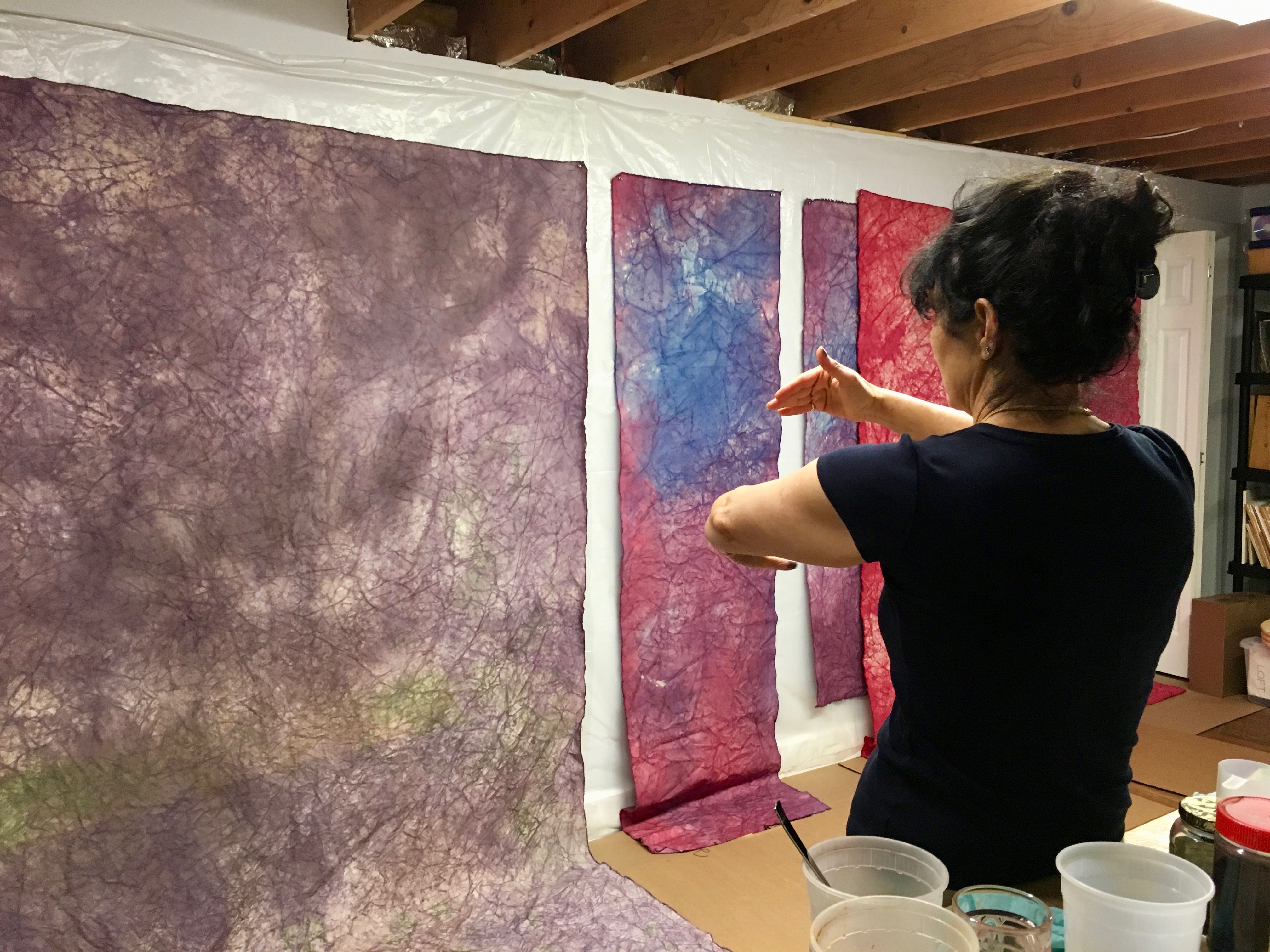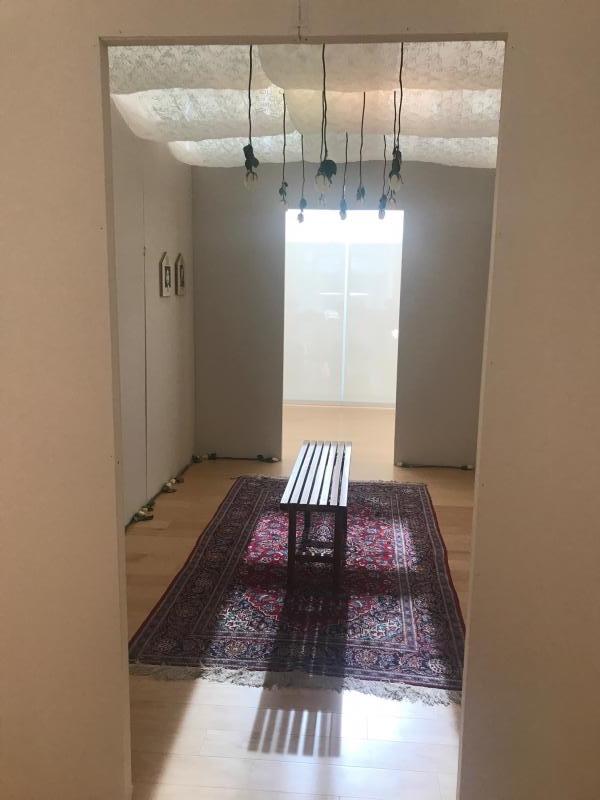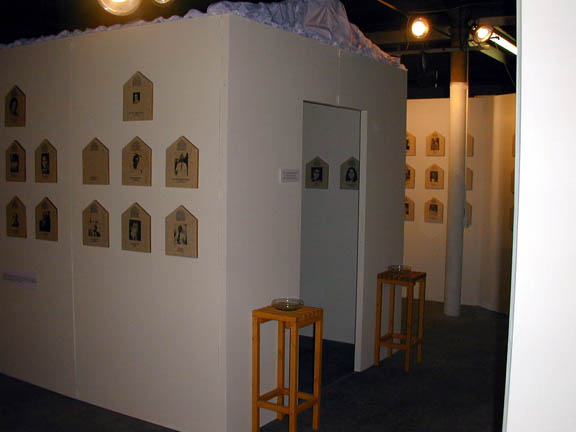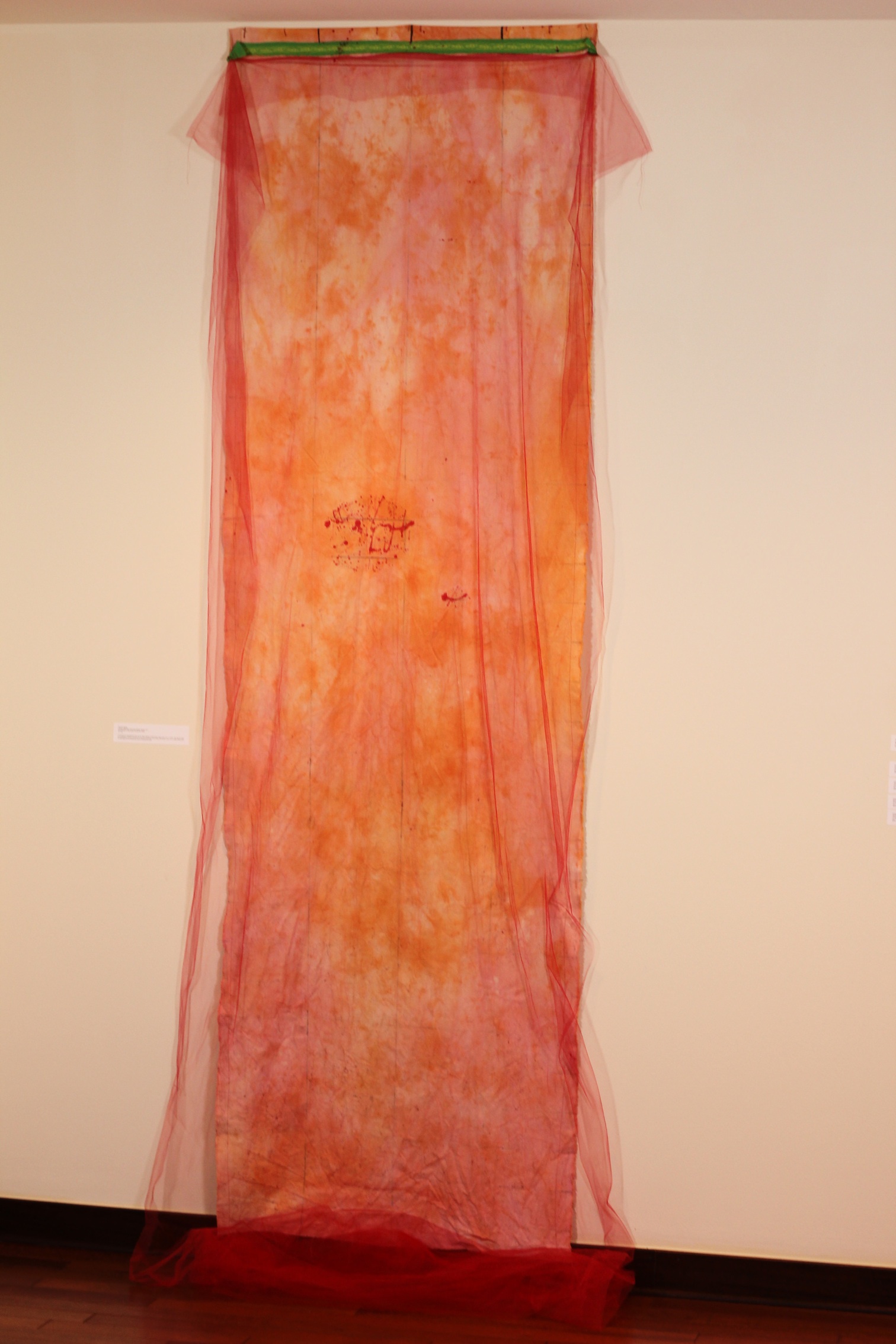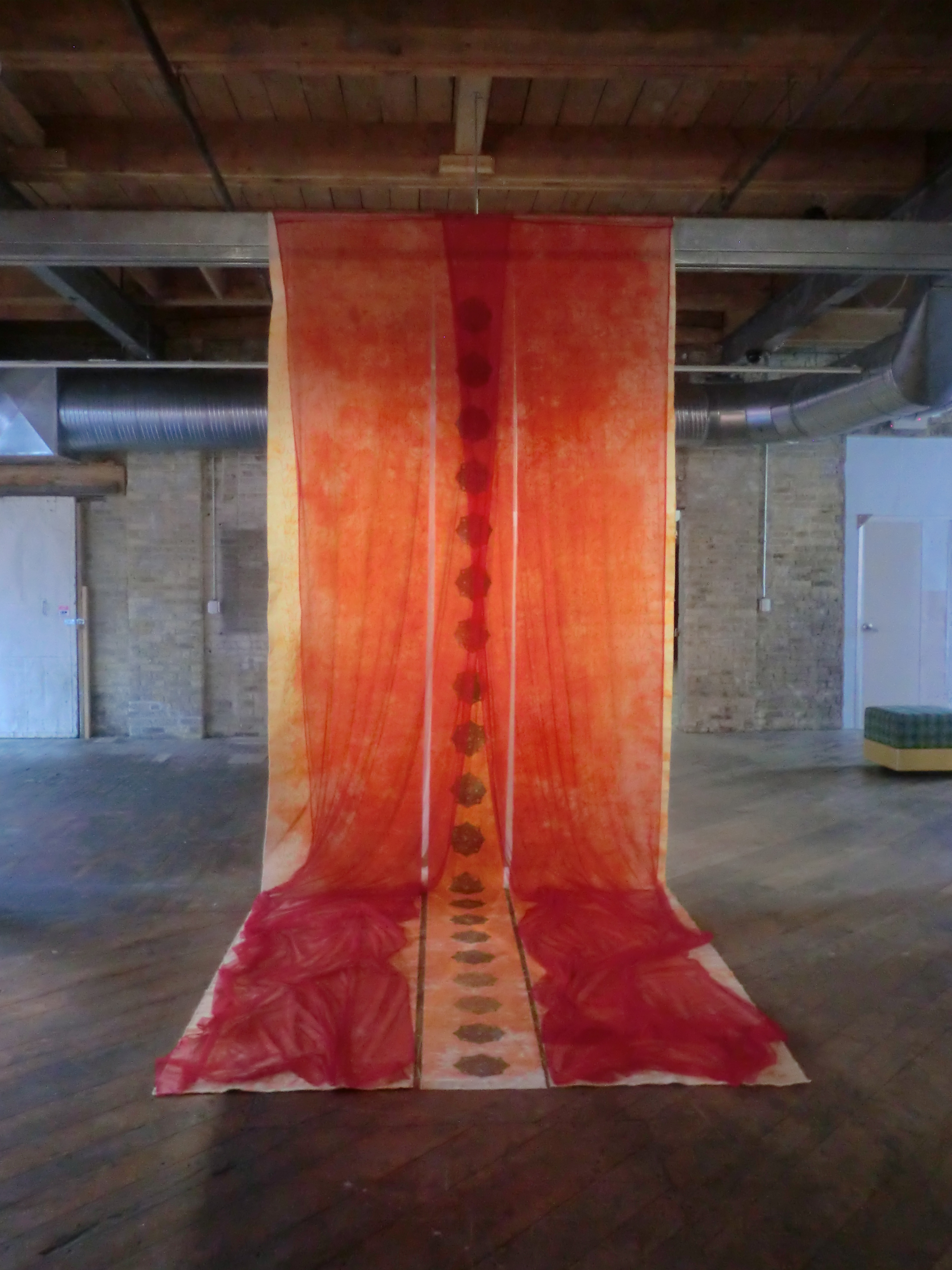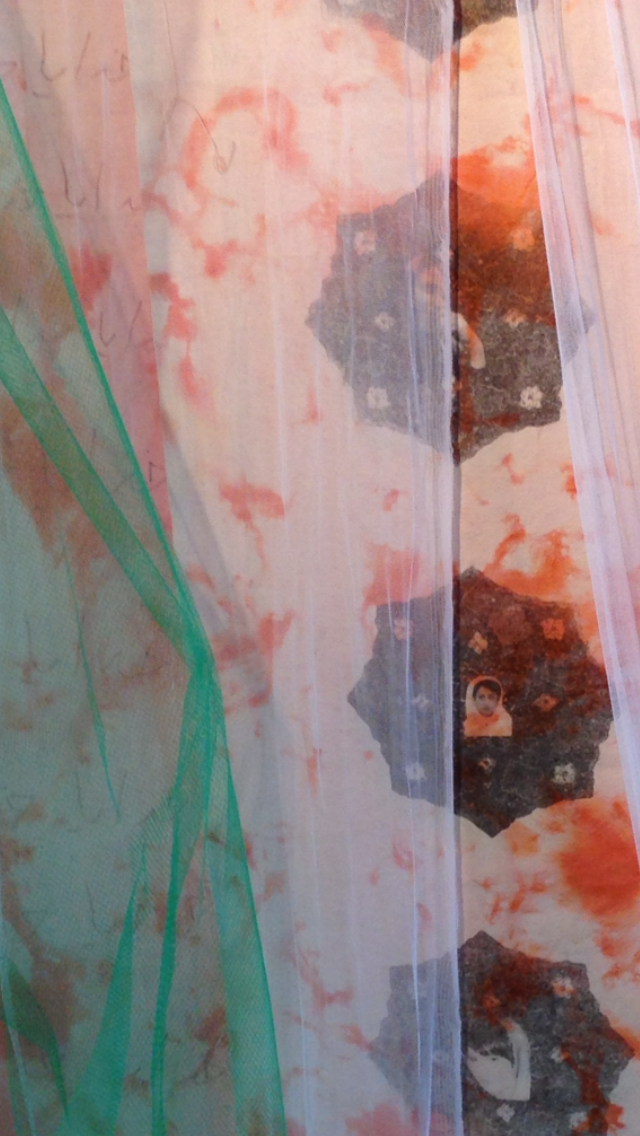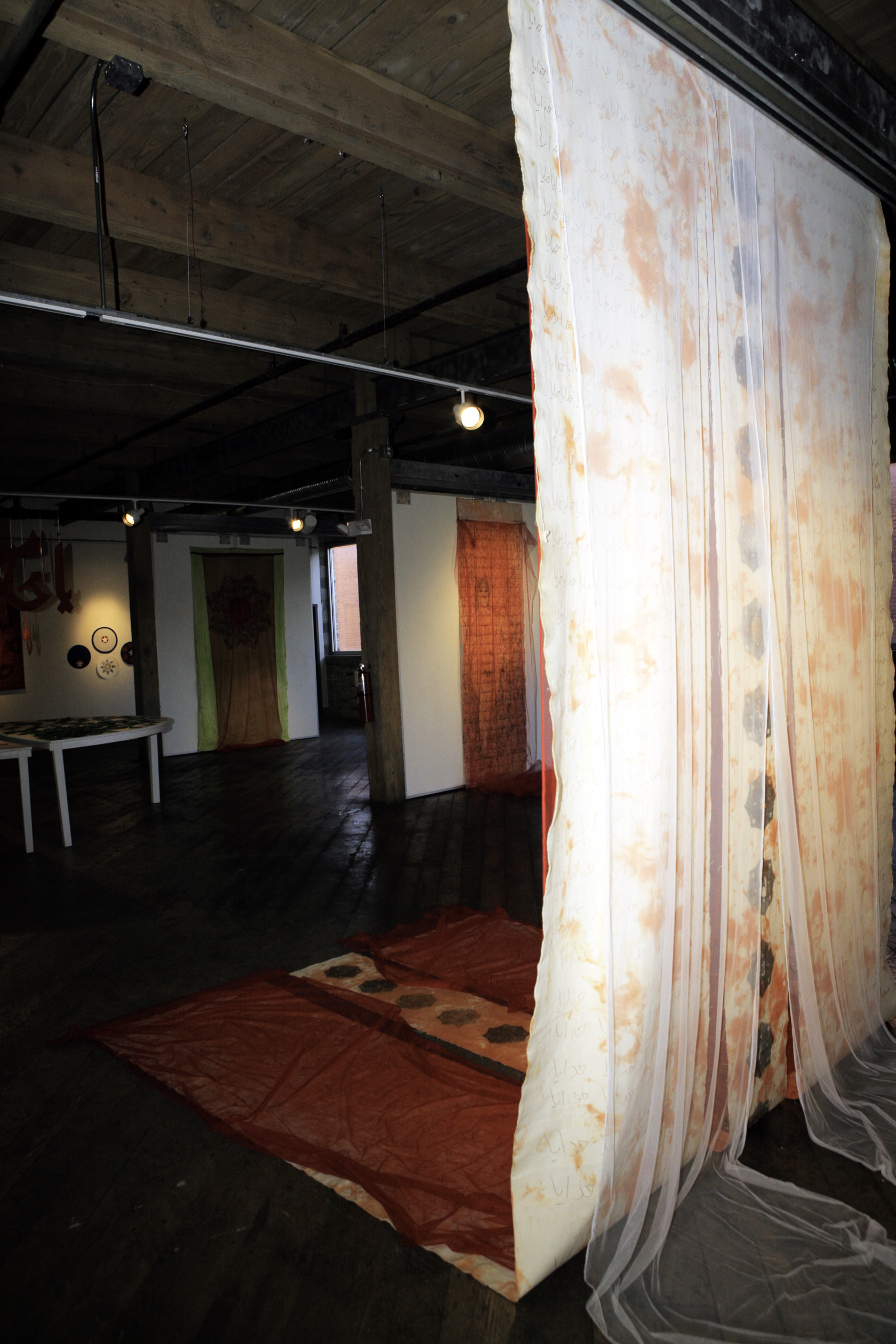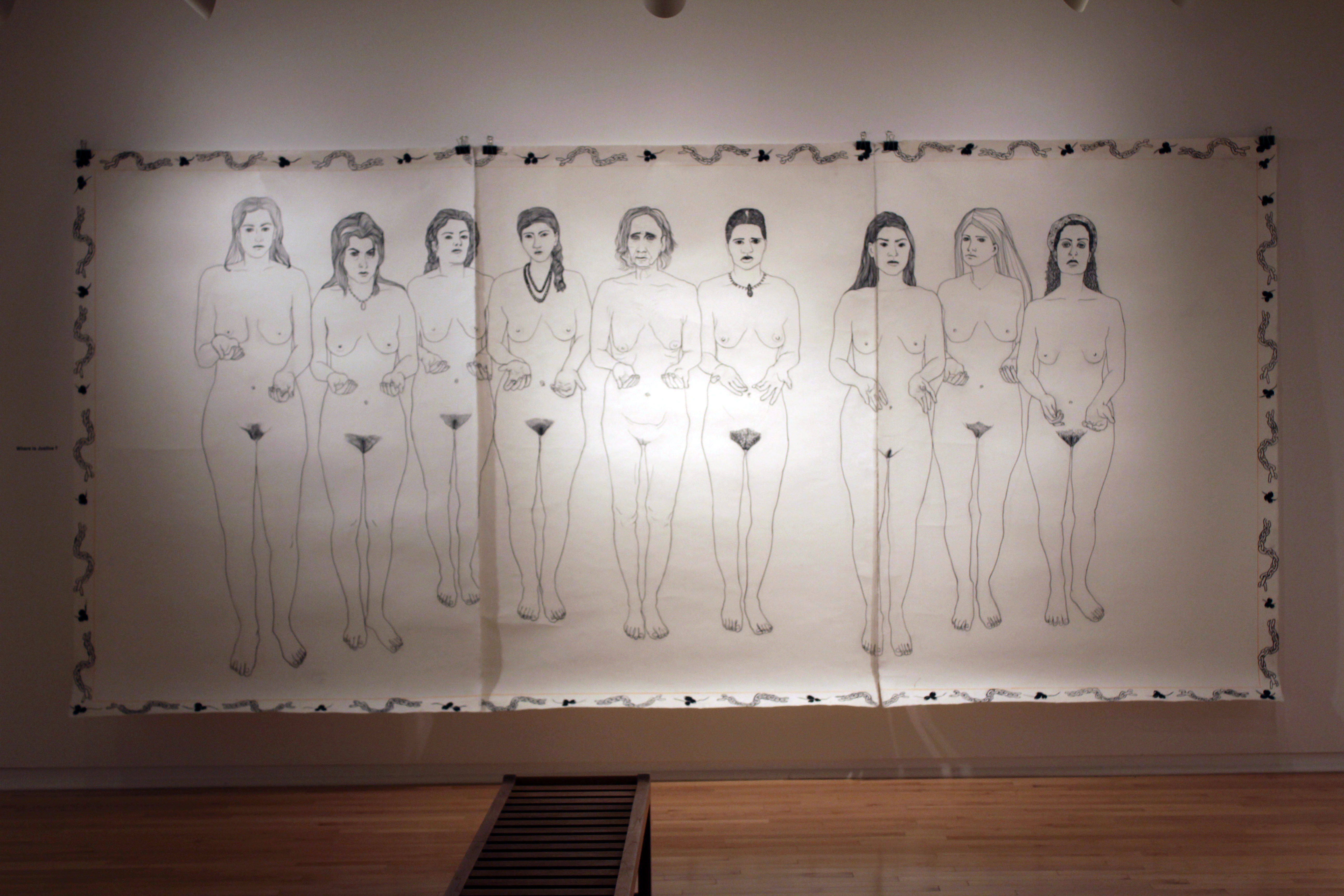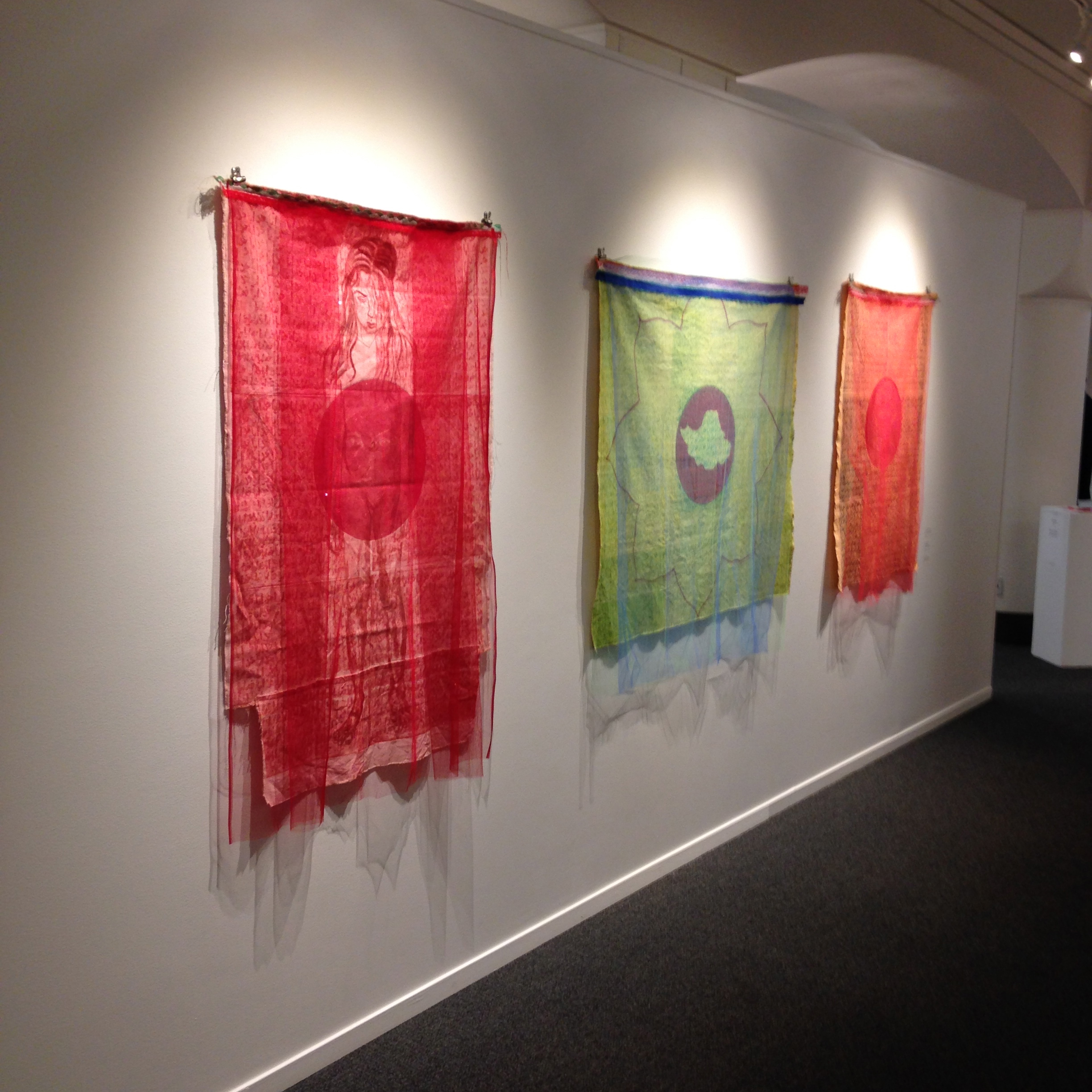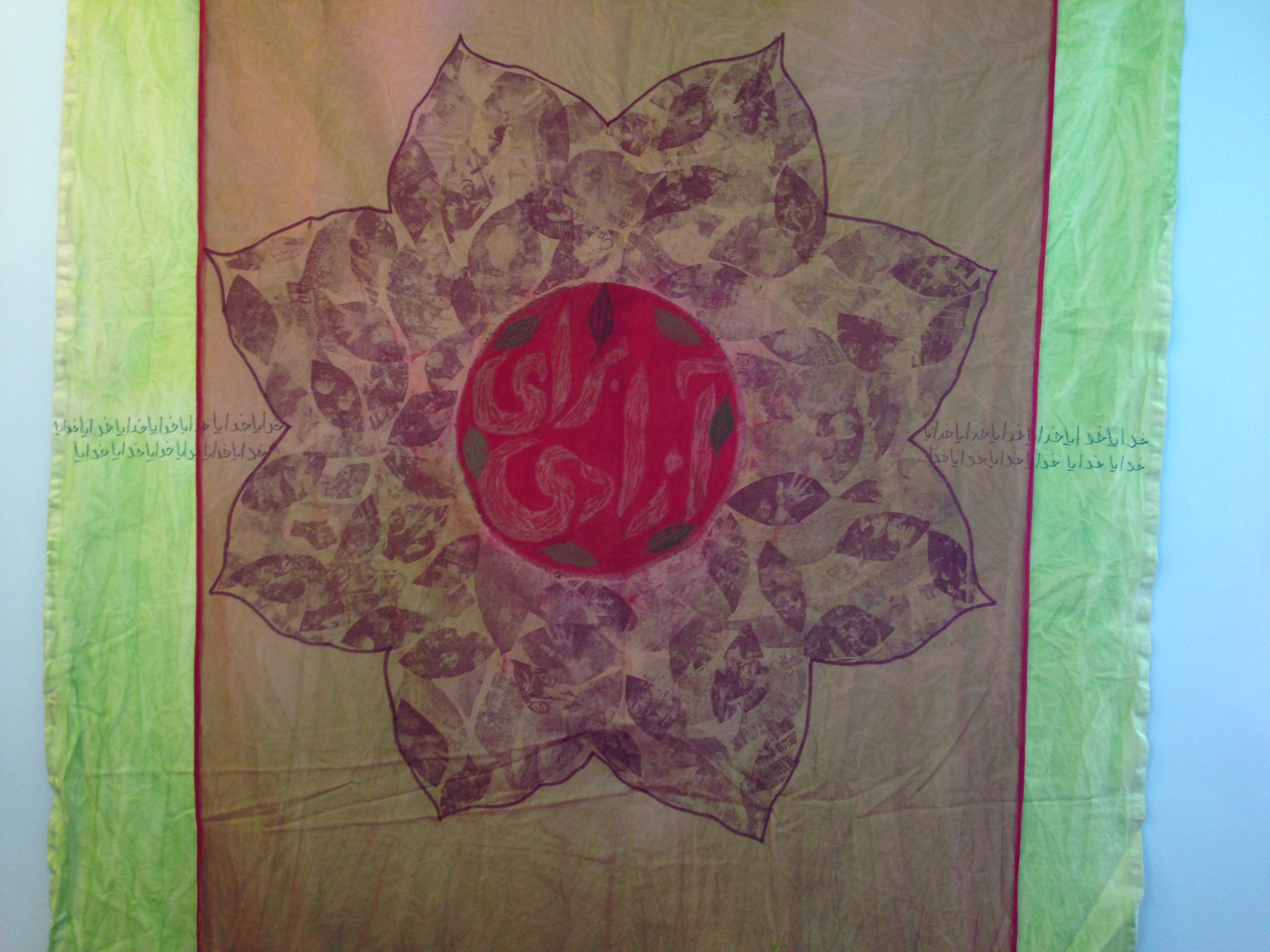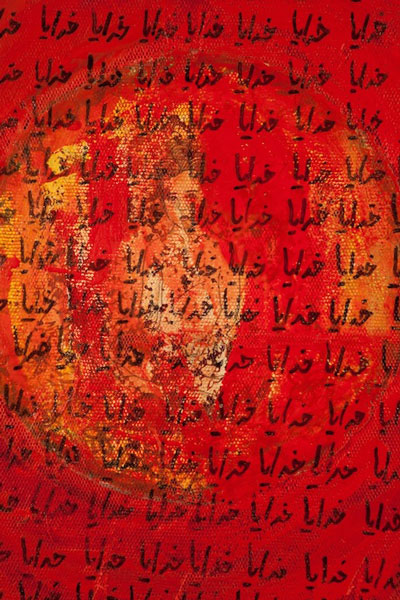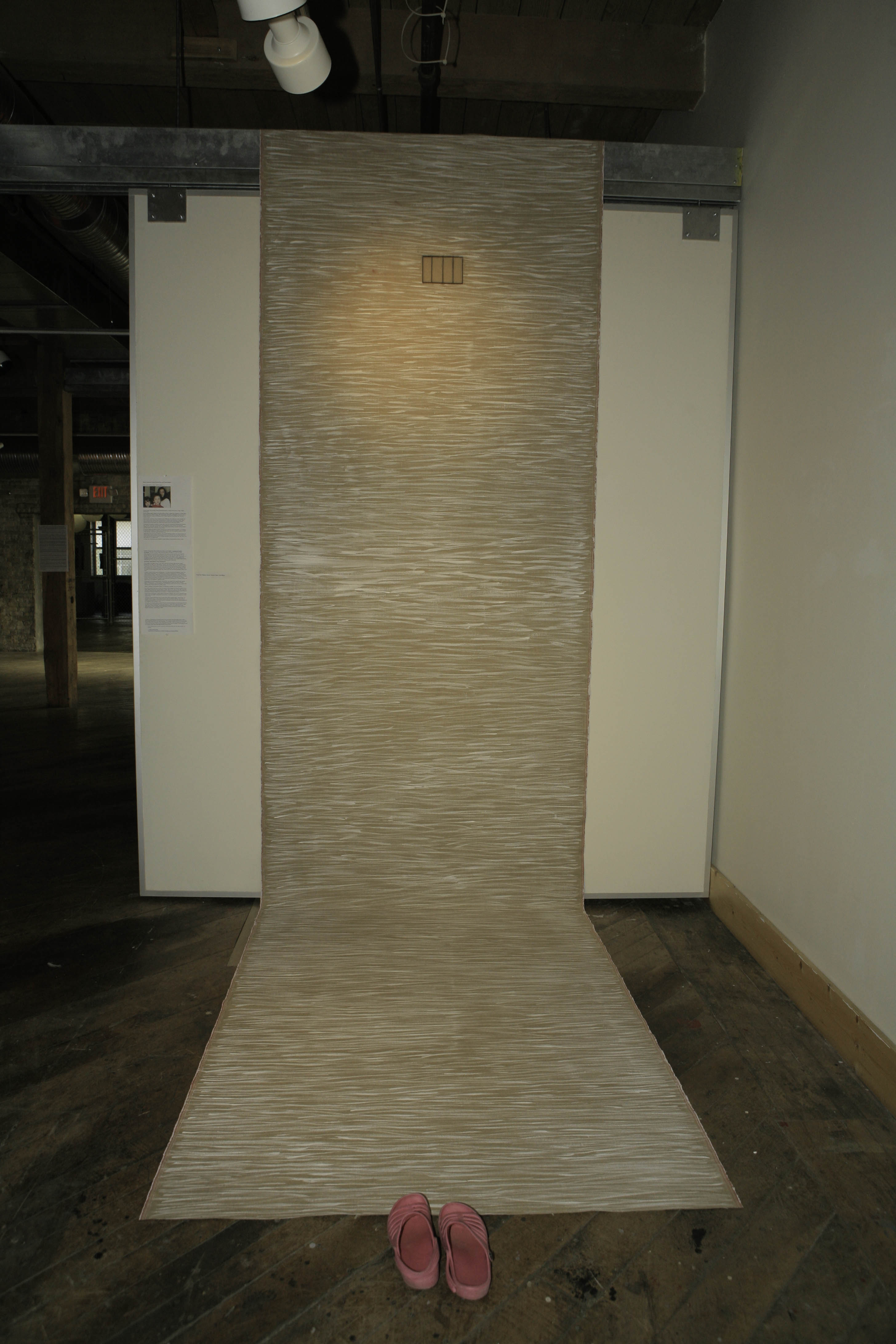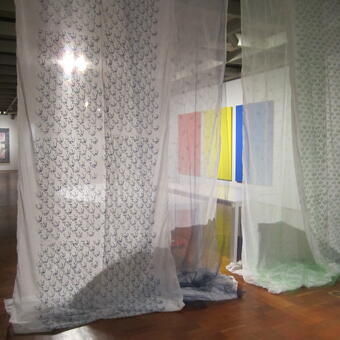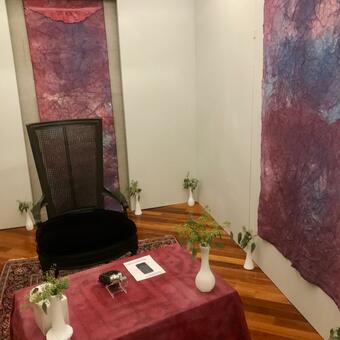Work samples
-
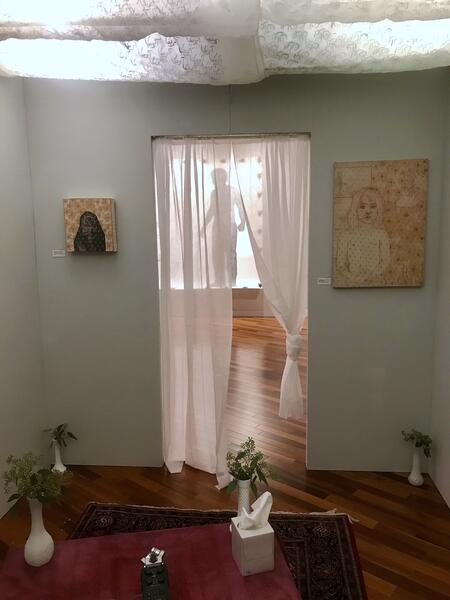 Interactive Mixed Media Installation, Safe Room from "Get Your Power Back" series, since 2019
Interactive Mixed Media Installation, Safe Room from "Get Your Power Back" series, since 2019This interactive and multi-media installation entitled: "Safe Room" is from my "Get Your Power Back" series. It is a room constructed of painted wood 10'X8'X 12' housed in the gallery space with sheer layered screen-printed fabrics as the rooftop which creates an ambient lighting hence enhances the atmosphere of calmness and warmth. A comfortable single chair is to designate only one person could enters the "Safe Room" at a time. The safe room has related paintings and textiles on the walls, several white vases with flowers around the space, a Persian rug on the floor with a coffee table, a set of curtains to offer privacy to the person in the "Safe Room", an audio recorder to invite the survivors of domestic violence to share their stories in attempt for deep scars healing and to getting their power back. As the person enters the room, closes the curtain, and sits on the chair, they enter a safe space where emotional and physical healing could begin...Although through the sheer curtain, they encounter a stark charcoal drawing outside of the "Safe Room" across the wall, stands a life size person with a closed fist emanating rage...A reminder...
The large charcoal drawing is from my series entitled: What Will Befall Her?, 7' X10'.
-
 fv_performance_Khodanoor.jpg
fv_performance_Khodanoor.jpgOn November 11, 2022, this street art protest performance was held on the US Capitol grounds in solidarity with the Women, Life, Freedom Movement in Iran. This uprising was sparked by the killing of Mahsa Amini, a 22-year-old woman, by the morality police in Tehran on September 15, 2022. The performance served as a poignant reminder of the atrocities faced by people of Iran for the last 45 years. This specific performance was in memory of Khodanoor, a 27-year-old man who was tortured with his hands tied to a pole in a public square in Zahedan for 24 hours. Despite being denied food and water where the heat was over 90 degrees, a cup of water was placed near him in a cruel irony. Tragically, he was shot to death by the Islamic Republic of Iran forces along with 67 people during a peaceful protest on September 30, 2022 in support the uprising. Khodanoor loved dancing, therefore, a painting of him while dancing was displayed during my performance with a cup of water near me. My hands are tied sitting on a specific position on the US Capitol ground for almost an hour. It was a cold night. The performance aimed to raise awareness about the human rights violations and gross injustices that continues to take place in Iran since 1979. Photo credit, Ali Mohammadi.
-
 FVahdat-IAmIran_I AmAmerica.jpg
FVahdat-IAmIran_I AmAmerica.jpgFrontal View: Fabricated Wood, Screen Printing on the severed (two unequal) tabletops, Three-tiered Egg Tempera Paintings on the floor, Three-layered hanging Screen Printed Fabrics and lace, Stacks of Hand Printed Papers,1"X4" for the Interactive Part of the Installation, (not shown). This site specific and interactive mixed media installation at the Milwaukee Art Museum is entitled, I am Iran I am America. Also this is the only artwork that symbolically deals with my difficult journey from Iran to America 45 years ago. I have not been back to Iran since I was forced to leave in 1980, but my internalized and genuine connection for the motherland continues. Becoming an American was both exhilarating and meaningful for me especially that I could serve my adoptive country in freedom and with respect. The poignant aspect of this work deals with the most heinous crimes the Islamic Republic of Iran has systematically committed and regularly since 1979 against the people of Iran is the executions of prisoners of conscience and children in high numbers. The focus of this installation is on the political relationship or lack of between the USA and Iran. Although many high profiles deals have been made between the two countries behind closed curtains and closed doors.Both countries ignore the gross human rights violations that take place daily toward the people of Iran especially women and girls under the totalitarian patriarchal government.
-
One Million Signature Campaign to Change the Women's Gender Based Apartheid Civil Rights in Iran, 2016
The title of this work is from my "Freedom" series with the subtitle: One Million Signature Campaign to Change Women's Civil Rights in Iran, 2007-2016. This is a version of the installation shot that we could not walk around the piece to witness both sides of it. This 248" tall and 84' width with 6" depth stands massively from the ceiling, crawling into the floor with several layers of sheer fabrics representing the colors of Iran's flag. I dared myself in a performance to make two straight cuts from the center of the canvas all the way to the top that holds it together to the larger piece on the top of the pole. Before starting on this project, I hand-dyed the canvas with vegetables dyes on the shore of Lake Michigan. It embodies mixed media prints of women who were imprisoned for collecting signatures for this cause going door to doors. Among the prisoners were lawyers, poets, writers, filmmakers, artists, college students, etc,.
In collaboration with these women in Iran I started to sign the word "Khodaya" as my signature to collect up to one million. I started to write this word on many of my artwork starting with this massive work. I have collected up to 6100,000 signatures so far. These signatures are imbedded in many of my work. The painting to the right is entitled: Twin Towers from my "Freedom" series, in memory of the people who lost their lives tragically during the terrorist attack on the Twin Towers in NYC. The painting to the left is entitled: Adel Abad Prison, Shiraz, Iran, where my 80 years-old uncle and my 32 years-old cousin were executed solely for their beliefs in Baha'i Faith in 1982. Collecting the signatures still continues until I reach my set goal of one million for this project.
About Fahimeh
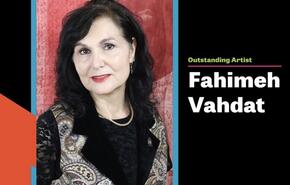
Fahimeh Vahdat, born in Iran, is an American mixed-media installation/performance artist and a women’s, children’s, and human rights activist, including the LGBTQ communities. She is based in the Greater Baltimore/Washington DC region. Vahdat’s work consistently addresses contemporary social issues through a variety of traditional and non-traditional materials, including fiber, dyes, wood, found and natural materials, paper, canvas, and her own body. Sewing, veiling,… more
From "Get Your Power Back" series, Color of Violence & Stages of Wound Healing
Art Review by Greg McLemore, art writer & artist, Baltimore, MD, best explains this body of work.
Fahimeh Vahdat’s exhibition, Take Your Power Back, recently on view at The Rouse Gallery at Howard Community College in Columbia, MD, is a masterful and complex exploration of two opposing forces; those of the Victim and the Hero (please see the video of these 20 heroes/revolutionary women of USA and Iran under the extended portfolio).
First, we will explore the Victim of physical violence. As described by the artist, the flesh wound goes through four stages, but changes its color eight times during the entire healing process. These colors start with the very bright red color of fresh blood, to a darker, deeper and cloudy red of the scab. As healing continues, bruises develop, having colors that range from blue, blue- purple, purple, green- blue, brownish with yellow patches, and finally yellowish. When the wound completely heals, it may have a deep amber, and whitish scar for a while, depending on the color of the skin.
Vahdat represents these colors of violence through a series of works, each created with mixed media- an amazingly complex, yet very subtly intertwined mix of collage, sewing, embroidery, pigment, charcoal, glue, lace and fabric, on hand dyed canvas. These large veiled works take time to see and more time to fully internalize. While each is very different, they are tied together by large veils of translucent red, purple, greenish, and yellow fabric. Behind the fabric we begin to see beautifully drawn figures, those that have withstood attack and abuse. One of the many things that strikes me, while looking at the work, is how perfectly the drawings of figures are combined with the fabric, and how naturally, even quietly, these troubled figures seem to exist. They remind me of ghosts. And here I must bring in the reference to Gustav Klimt because they remind me of his work- or rather, I can see the ghosts of his work in Vahdat’s. While Klimt used heavily patterned spaces and beautifully drawn female figures, Vahdat uses softer, gauzier patterning, and figures (often maternal figures and sometimes children) that appear translucent- more an integrated part of the space.
As one walks through the exhibition, towards the back of the gallery, a room has been constructed. This room is covered in fabric and rugs and feels very soft and inviting. There is a chair where the viewer can sit and a device with which you are requested to anonymously record an act of violence or abuse you have endured. Vahdat intends to use the information within these recordings for her next project. Within the room is also a very compelling image of a young vulnerable girl, standing beside a maternal, protective figure, titled My Mother and I. This adds to the feeling of safety Vahdat wants to convey in this Safe Room.
A particularly ominous aspect of this installation is that while you at first feel very safe in the room, you soon realize that the there is a large dark, shadowy figure, just outside of the door, peering in. This dark figure is part of another mixed media work, but the positioning of it, in relation to the door of the installation, has a very intimidating feeling.
In summary, Fahimeh Vahdat’s Take Your Power Back, is an exhibition full of depth, meaning, and beauty. Her works unfolds slowly in time, displaying a true level of mastery and integrity in the process. She is particularly adept at mixing materials that a less skilled artist could never pull off. That said, the content of the work takes center stage, and this content is certainly worth experiencing.
-
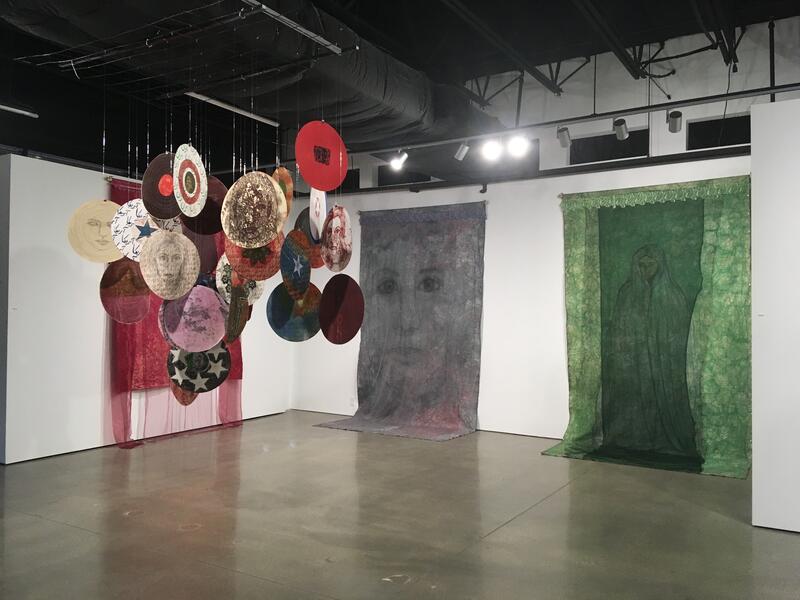 Installation shot, artwork from "Get your Power Back" series and print installation from "Freedom" series, Children of Aleppo, January, 2020 before PandemicBeing an activist artist is a privilege. It is a responsibility that extends beyond my occupation. Through my work, I take an active role to effectively become an agent for positive change. My view as a world citizen is my intent for elimination of all types of violence, racial and gender-based prejudices, and inequities in society. The focus of my current body of work is on protest art and performances. Protest art especially live performances act as a poignant tool to form social consciousness for positive change in public places. The ongoing body of work is entitled: “Get Your Power Back” from the “Color of Violence and Wound Healing” series, is on generating public awareness on the short- and long-term effect of domestic violence on people by sharing told and untold stories of survivors of domestic violence particularly from Iran and the United States of America.
Installation shot, artwork from "Get your Power Back" series and print installation from "Freedom" series, Children of Aleppo, January, 2020 before PandemicBeing an activist artist is a privilege. It is a responsibility that extends beyond my occupation. Through my work, I take an active role to effectively become an agent for positive change. My view as a world citizen is my intent for elimination of all types of violence, racial and gender-based prejudices, and inequities in society. The focus of my current body of work is on protest art and performances. Protest art especially live performances act as a poignant tool to form social consciousness for positive change in public places. The ongoing body of work is entitled: “Get Your Power Back” from the “Color of Violence and Wound Healing” series, is on generating public awareness on the short- and long-term effect of domestic violence on people by sharing told and untold stories of survivors of domestic violence particularly from Iran and the United States of America. -
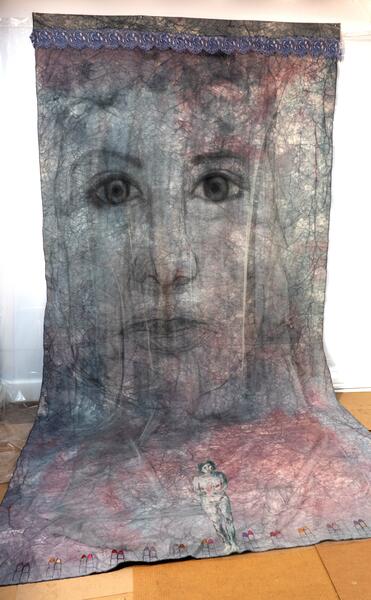 Vahdat_F_LargeGray.jpg
Vahdat_F_LargeGray.jpgGallery shot from "Get your Power Back" exhibition. The large hand-dyed mixed media canvas, 12'X 72" X4" is entitled the Color of violence.
-
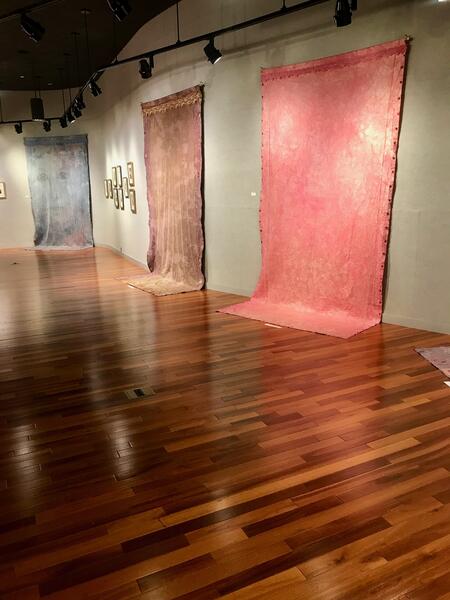 Gallery Shot from Get Your Power Back Installation, 2019
Gallery Shot from Get Your Power Back Installation, 2019 -
Color of Violence - Installation ShotFrom the "Get Your Power Back" series, Color of Violence and 8 Stages of Wound Healing, deals with both physical and psychological healing after a violent act - Gallery shot. Hand-dyed canvases 13'X7' each were carefully treated with vegetable dyes to create various colors of trauma healing both physical and psychological healing after a violent act. Layers of sheer fabrics, laces and embroideries are a part of each piece.
-
 The "Safe Room" Installation, 10'X8'X 12'
The "Safe Room" Installation, 10'X8'X 12'This interactive and multi-media installation entitled: "Safe Room" is from my "Get Your Power Back" series. It is a room constructed of painted wood 10'X8'X 12' housed in the gallery space with sheer layered screen-printed fabrics as the rooftop which creates an ambient lighting hence enhances the atmosphere of calmness and warmth. A comfortable single chair is to designate only one person could enters the "Safe Room" at a time. The safe room has related paintings and textiles on the walls, several white vases with flowers around the space, a Persian rug on the floor with a coffee table, a set of curtains to offer privacy to the person in the "Safe Room", an audio recorder to invite the survivors of domestic violence to share their stories in attempt for deep scars healing and to getting their power back. As the person enters the room, closes the curtain, and sits on the chair, they enter a safe space where emotional and physical healing could begin...Although through the sheer curtain, they encounter a stark charcoal drawing outside of the "Safe Room" across the wall, stands a life size person with a closed fist emanating rage...A reminder...
-
Safe room from " Color of Violence" Series, Mixed Media installation
Get Your Power Back has started since 2017 and is ongoing. The prevalence of domestic violence has risen dramatically during the Covid-19 pandemic since intimate partners are forced to stay at home with their children and pets when public shelters are shut down”. Mixed Media.
-
Research Material of Revolutionary Women of USA and Iran, from 1848 to 1960. Solarplate Etchings --Fahimeh Vahdat
Extensive research was conducted for the "Get Your Power Back" series, which comprises 20 Solarplate etchings. This series explores the experiences of revolutionary women in Iran and the United States from the mid-1800s to 1960. It delves into the origins of the women's rights and civil liberties movements in both countries and highlights the striking similarities between early gatherings and conferences advocating for women's equality. This collection will be presented in a limited edition artist book.
-
 Gunshot Wound, from the "Get Your Power Back" series Eight Stages of Healing Wound. Hand-dyes canvas, sewing, lace fabric and ink.
Gunshot Wound, from the "Get Your Power Back" series Eight Stages of Healing Wound. Hand-dyes canvas, sewing, lace fabric and ink. -
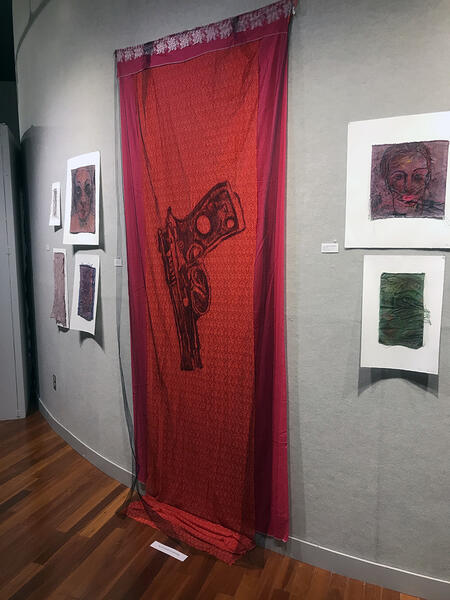 F_Vahdat_11_GunViolence.jpg
F_Vahdat_11_GunViolence.jpgUse of guns in domestic violence has increased drastically. In recent decades, domestic violence has been recognized as the world’s most serious social problem, crossing cultural, social, and geographical boundaries to the extent that it is found in all societies and across all social classes. It is considered one of the main health problems among women given the negative effects of domestic violence on physical, mental, and pregnancy health. Although the problem of domestic violence is serious, it can be tracked and monitored, and women can be screened for signs of domestic violence during routine health services. Tracking domestic violence is the first step in dealing with the problem. (NCBI resources)
-
 FV_In the Studio.jpeg
FV_In the Studio.jpegMy comparative research continuous to be on domestic violence statistics in Iran and USA. in both countries domestic violence is high but the form of abuse varies and different in each country. Structural abuse is enforced in Iran by patriarchy power and in USA by baring gun Amendment that allows significant use of gun in domestic violence more than any other country in the world.
Protest Art: Street Performance & Collaborative Art with the Public
A Women-Led Revolution was ignited in Iran on September 16, 2022, following the killing of Mahsa Amini, 22, at the hands of the Morality police in Tehran for not wearing her hijab properly. People began protesting by the thousands all over Iran, a movement that persists despite over 20,000 young women and men facing imprisonment under severe conditions of torture and rape. However, resistance continues throughout Iran for regime change and the establishment of democracy and equality. Over 1000 people have been killed since September 2022.
KhodaNoor, a 27-year-old man from the Baloochstan region in Iran, who loved dancing, had his life cut short by torture and death at the hands of Iran's brutal regime. His story of suffering was so grave that people around the world reacted to the cruel way his hands were tied to a post in the middle of a square during intense heat for over 24 hours. A cup of water was placed a foot away from him for unimaginable physical and psychological torture.
Iranian Americans in the DC area are very active in protesting the criminal regime and standing in solidarity with the movement in Iran. During the one-week Sit-in on the US Capitol grounds in protest, my performance was conducted in memory of KhodaNoor, aiming to honor him and raise awareness about the Women, Life, Freedom Movement in Iran. Despite its simple setup on the grass on a cold November night, this performance was powerful, leading both men and women to tears throughout its 45-minute duration. Barefoot, with hands tied to a post by a rope, sitting on the grass in the same position as KhodaNoor, and adorned with bloody clothes (wet red paint), I remained motionless and silent, commemorating KhodaNoor and the 67 young people killed that day for peaceful protest.
-
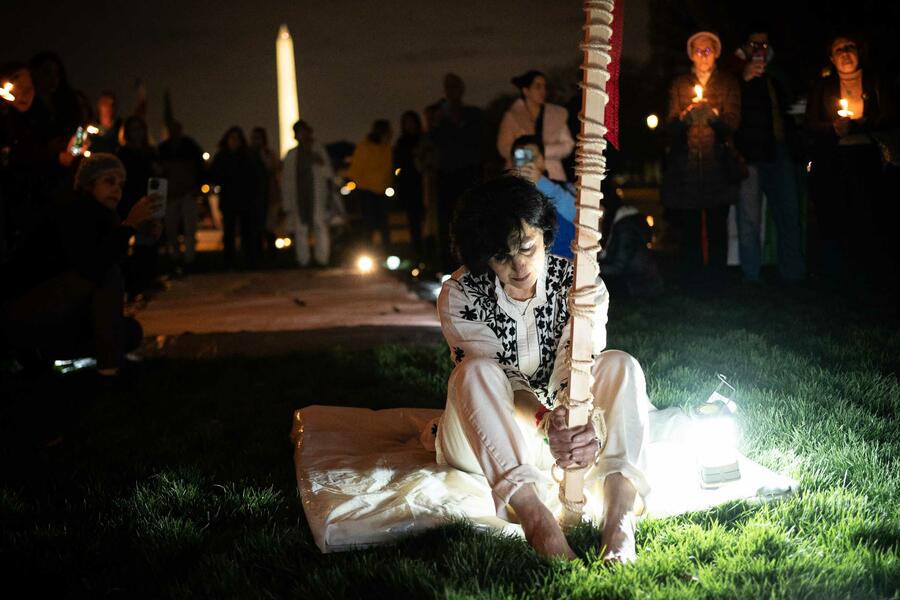 Street Art - Protest Performance - The US Capitol Grounds, Washington DC, 11-11-2022On November 11, 2022, this street art protest performance was held on the US Capitol grounds in solidarity with the Women, Life, Freedom Movement in Iran. This uprising was sparked by the killing of Mahsa Amini, a 22-year-old woman, by morality police in Tehran on September 15, 2022. The performance serves as a poignant reminder of the atrocities faced by people of Iran for the last 43 years including Khodanoor, a 27-year-old man who was tortured with his hands tied to a pole in a public square in Zahedan. Despite being denied food and water where the heat was over 90 degrees, a cup of water was placed near him in a cruel irony. Khodanoor loved dancing therefore, a painting of him dancing is being displayed during the performance. Tragically, he was shot to death by the Islamic Republic of Iran forces along with 67 people for participating in a peaceful protest on September 30, 2022. The performance aims to raise awareness about the human rights violations and gross injustices take place in Iran since 1979. Photo credit, Ali Khalgh.
Street Art - Protest Performance - The US Capitol Grounds, Washington DC, 11-11-2022On November 11, 2022, this street art protest performance was held on the US Capitol grounds in solidarity with the Women, Life, Freedom Movement in Iran. This uprising was sparked by the killing of Mahsa Amini, a 22-year-old woman, by morality police in Tehran on September 15, 2022. The performance serves as a poignant reminder of the atrocities faced by people of Iran for the last 43 years including Khodanoor, a 27-year-old man who was tortured with his hands tied to a pole in a public square in Zahedan. Despite being denied food and water where the heat was over 90 degrees, a cup of water was placed near him in a cruel irony. Khodanoor loved dancing therefore, a painting of him dancing is being displayed during the performance. Tragically, he was shot to death by the Islamic Republic of Iran forces along with 67 people for participating in a peaceful protest on September 30, 2022. The performance aims to raise awareness about the human rights violations and gross injustices take place in Iran since 1979. Photo credit, Ali Khalgh. -
 Fahimeh Vahdat, Protest Performance for KhodaNoor, The US Capitol Grounds, 11.11.2022My hands were tied with a rope around the wooden pole to represent the way KhodaNoor was tied down to a metal pole in the middle of a square. A cup of water set near me symbolized the curtly he endured during a very hot day and cold night while thirsty and hungry with his hands tied. Photo credit, Ali Khalgh.
Fahimeh Vahdat, Protest Performance for KhodaNoor, The US Capitol Grounds, 11.11.2022My hands were tied with a rope around the wooden pole to represent the way KhodaNoor was tied down to a metal pole in the middle of a square. A cup of water set near me symbolized the curtly he endured during a very hot day and cold night while thirsty and hungry with his hands tied. Photo credit, Ali Khalgh. -
Group protest performance at the National Monument in DC for the killing of the people in Baluoochestan, Iran, 2022
This protest street performance at the National Monument, protesters including myself were bound to flagpoles at the National Monument next to depictions of those unjustly killed, including Khodanoor. This powerful portrayal pays tribute to the hundreds of innocent lives lost, conveying a profound message of resilience and a fervent call for justice for the Baluoochi people.
-
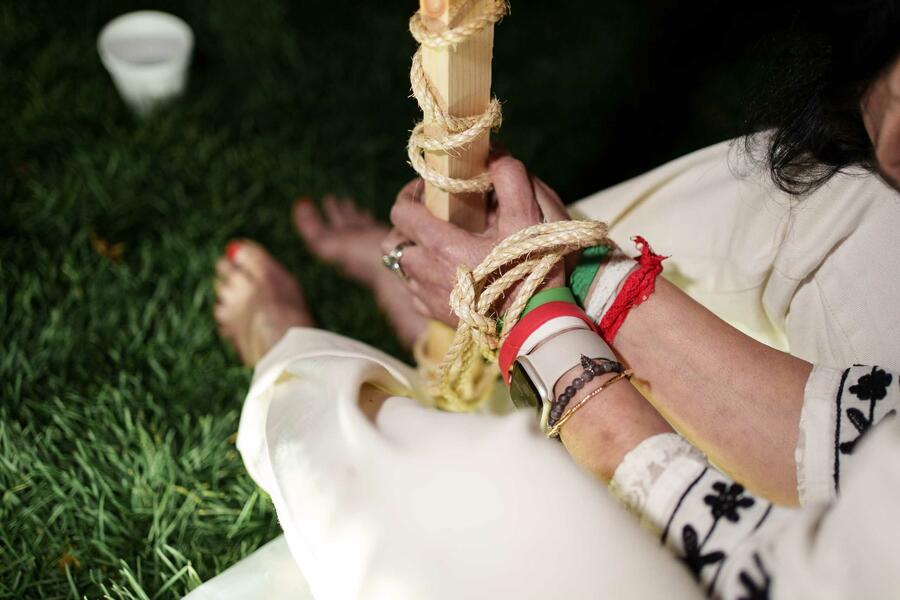 Street Art - Protest Performance - The US Capitol Grounds, Washington DCMy hands were tied with a rope around the wooden pole to represent the way KhodaNoor was tied down to a pole in the middle of a square. A cup of water set near me symbolized the curtly he endured during a very hot day and cold night while thirsty and hungry with his hands tied to the metal pole. Photo credit, Ali Khalgh.
Street Art - Protest Performance - The US Capitol Grounds, Washington DCMy hands were tied with a rope around the wooden pole to represent the way KhodaNoor was tied down to a pole in the middle of a square. A cup of water set near me symbolized the curtly he endured during a very hot day and cold night while thirsty and hungry with his hands tied to the metal pole. Photo credit, Ali Khalgh. -
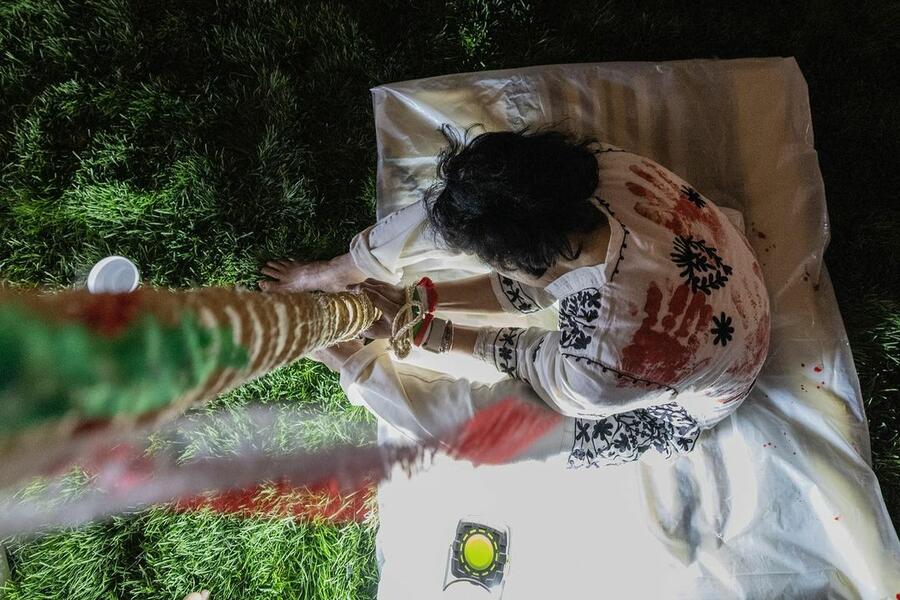 Street Art - Protest Performance - The US Capitol Grounds, Washington DCThe Protest performance started by two people from the audience dipping their hands in red paint representing blood smearing them on my back while large audience were holding a candlelight vigil for Khodanoor and other 67 victims of the Women, Life, Freedom Movement on September 30 in Iran. Photo credit, Ali Khalgh.
Street Art - Protest Performance - The US Capitol Grounds, Washington DCThe Protest performance started by two people from the audience dipping their hands in red paint representing blood smearing them on my back while large audience were holding a candlelight vigil for Khodanoor and other 67 victims of the Women, Life, Freedom Movement on September 30 in Iran. Photo credit, Ali Khalgh. -
FVahdat_Performance-USCapitol
In support of the uprising in Iran and the Women, Life, Freedom Movement led by Iranian women, and the killing of many young protesters in different parts of Iran by the brutal forces, I had a performance on the US Capitol grounds in memory of KhodaNoor Lejie, 27 who suffered torture prior to getting shot on September 30, 2022 in Zahedan, Iran. Video credit: Ramin Haghjoo
-
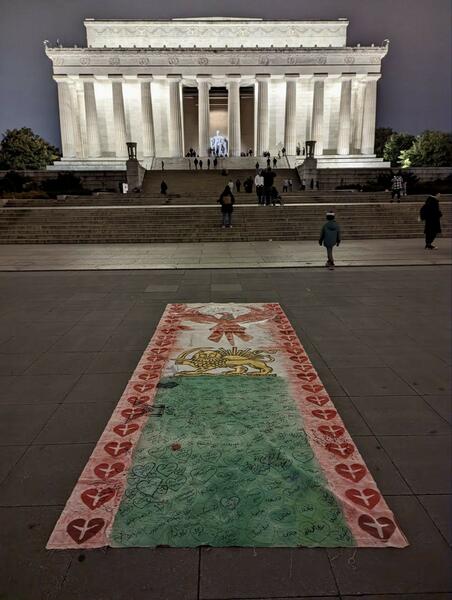 Protest Art, Memorial Tribute to Flight PS-752, in Memory of 176 victims, Lincoln Memorial, Washington DCThis large painting is a tribute to the Ukrainian Flight PS-752, in Memory of 176 victims, Lincoln Memorial, Washington DC on its third anniversary of the downing of the plane by the Iran's military missiles in Tehran killing all aboard. on the top of this painting is written, we will never forget, we will never forgive, justice for the victims of the flight PS-752. Each person’s name has been written on the green part of the painting in a hart shape form. Mixed Media Painting, 15'X7', placed in front of the Lincoln Memorial grounds, January 8, 2023.
Protest Art, Memorial Tribute to Flight PS-752, in Memory of 176 victims, Lincoln Memorial, Washington DCThis large painting is a tribute to the Ukrainian Flight PS-752, in Memory of 176 victims, Lincoln Memorial, Washington DC on its third anniversary of the downing of the plane by the Iran's military missiles in Tehran killing all aboard. on the top of this painting is written, we will never forget, we will never forgive, justice for the victims of the flight PS-752. Each person’s name has been written on the green part of the painting in a hart shape form. Mixed Media Painting, 15'X7', placed in front of the Lincoln Memorial grounds, January 8, 2023. -
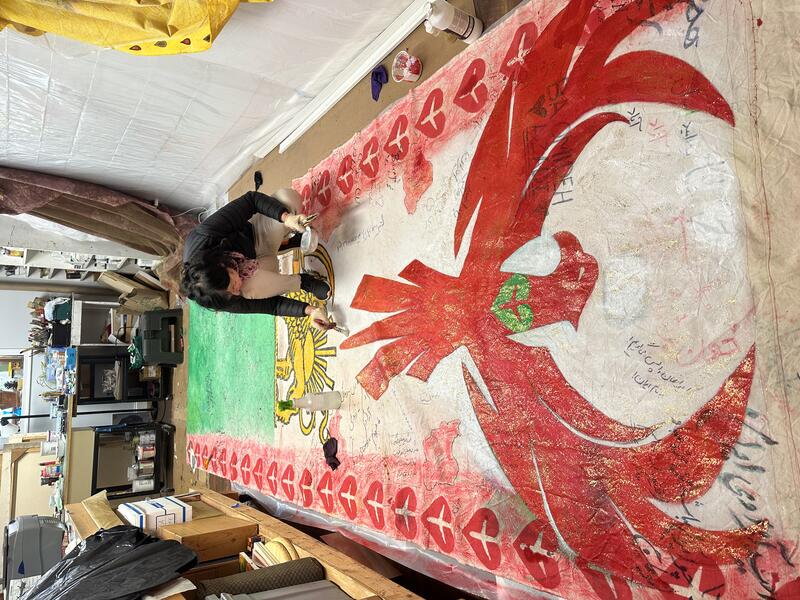 Fahimeh Vahdat in Studio for the downing of Flight752
Fahimeh Vahdat in Studio for the downing of Flight752In collaboration with the public in to demand justice from the criminal acts of the Islamic Republic of Iran for the downing of the Ukrainian flight PS-752 by shooting two missiles killing 176 passengers on board. I had a 13'X7' canvas to paint on. The public participation was amazing. This collaborative artwork was displayed the Lincoln Memorial Grounds. January 8, 2023, on the third anniversary of the PS-752 Flight in Tehran, Iran. Photo Credit, Bahman, Pedrood.
-
Fahimeh Vahdat - Street Art in collaboration with the public
In collaboration with the public in support of Women, Life, Freedom Movement for regime change in Iran and to protest the killing of Iranian people during this uprising, I had a 13'X7' canvas to paint on. The public participation was amazing. This collaborative artwork was displayed for several days on the US Capitol Ground. November 7, 2022. Video Credit: Ramin Haghjoo.
-
Street Protest Art - in collaboration with the public. Fahimeh Vahdat
I collaborated with the public to create a 13'X7' canvas painting in support of the Women, Life, Freedom Movement for the brutal regime change in Iran and as a protest the killings of Iranian people during the recent uprising. The public participated eagerly by dipping their hands in paint and writing slogans of solidarity with the people of Iran where they lose their lives or being imprisoned and tortured for demanding freedom and democracy. This collaborative artwork was displayed on the grounds of the US Capitol in Washington D.C. from November 5th to November 12th, 2022. Video credit: Ramin Haghjoo.
Protest Performance: Cutting Off My Hair, Women, Life, Freedom Movement in Iran
Protest art especially live performance act as a poignant tool to form social consciousness for positive change in public places. In this performance cutting my long hair that was my identity for the past 43 years since I have left Iran was an act of defiance against brutality of Iran regime which has inflicted gross sufferings on Iranian people since 1979. The women-let revolution in the making is the first movement in the world that has ignited by the Iranian women is going strong. On September 16, 2022, after the killing of Mahsa Amini, 22 at the hands of Morality police in Tehran for not wearing her hijab properly. Women started protesting on streets all over cities and towns by burning their hijabs and cutting their hairs off against tyrannical gender-based apartheid regime for 43 years. On September 28, 2022, in front of my artwork entitled: Get your power Back, from Mona, 17 to Mahsa, 22 and the audience at the Fredrick Layton gallery located at MIAD, Milwaukee, I cut my hair to join in solidarity and to protest the brutality of the regime against its own people in Iran especially women and girls. The Women-Led Revolution and their quest for freedom, equality and democracy continues which now has given power to the women in Afghanistan to fight for their rights against Taliban regime. The performance was very emotional and moving for both the audience and me.
-
Mahsa Amini Protest Performance 22 Fahimeh Vahdat
The women-let revolution in the making is the first movement in the world that has ignited by the Iranian women. On September 16, 2022, after the killing of Mahsa Amini, 22 at the hands of Morality police in Tehran for not wearing her hijab properly. Women started protesting on streets all over cities and towns by burning their hijabs and cutting their hairs off against tyrannical gender-based apartheid regime for 43 years. On September 28, 2022, in front of my artwork and the audience at a gallery in MIAD, I cut my hair to join in solidarity and to protest the brutality of the regime against its own people in Iran. The Women-Led Revolution and their quest for freedom, equality and democracy continues which now has given power to the women in Afghanistan to fight for their rights against Taliban regime. For Iranian women cutting off their hair is a sign of mourning and defiance against injustice.
-
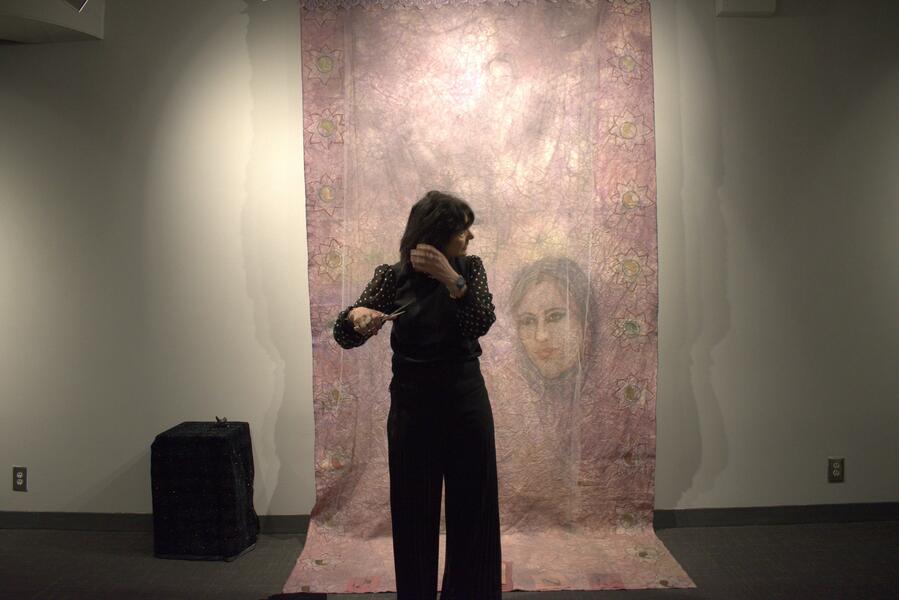 Protest Performance, Cutting Off My Hair for Women, Life, Freedom MovementFor Iranian women cutting off their hair is a sign of mourning and defiance against injustice. In Women, Life, Freedom Movement is a conscious form of protest the beauty that was decreed to be hidden. Women in Iran have dealt with compulsory hijab and veiling with the establishment of the Islamic Republic in 1979 which was aided by the West. Since then, the government has taken tight over women and girls and has tried to mold them in timid, helpless women who need men to live, but the long history of women movement in Iran with courageous women the government failed every step of the way. They would come up with new restrictions, but the women of Iran defy them over and over. The gender-based apartheid regime and its patriarchal government with morality police has made life impossible for women and girls in Iran until the killing of Mahsa Amini by the morality police for bad hijab. The uprising was ignited on September 15, 2022 and, continuing until their victory for freedom and democracy replaces the current brutal regime in Iran.
Protest Performance, Cutting Off My Hair for Women, Life, Freedom MovementFor Iranian women cutting off their hair is a sign of mourning and defiance against injustice. In Women, Life, Freedom Movement is a conscious form of protest the beauty that was decreed to be hidden. Women in Iran have dealt with compulsory hijab and veiling with the establishment of the Islamic Republic in 1979 which was aided by the West. Since then, the government has taken tight over women and girls and has tried to mold them in timid, helpless women who need men to live, but the long history of women movement in Iran with courageous women the government failed every step of the way. They would come up with new restrictions, but the women of Iran defy them over and over. The gender-based apartheid regime and its patriarchal government with morality police has made life impossible for women and girls in Iran until the killing of Mahsa Amini by the morality police for bad hijab. The uprising was ignited on September 15, 2022 and, continuing until their victory for freedom and democracy replaces the current brutal regime in Iran. -
 Protest Performance For Masha Amini & Women, Life, Freedom Movement in IranDuring the cutting off of my hair, I was filed with many emotional feelings that affected me with cry in silence, resilience and empowerment, trembling, anger seeing myself back in Iran as a 18-year-old young woman.
Protest Performance For Masha Amini & Women, Life, Freedom Movement in IranDuring the cutting off of my hair, I was filed with many emotional feelings that affected me with cry in silence, resilience and empowerment, trembling, anger seeing myself back in Iran as a 18-year-old young woman. -
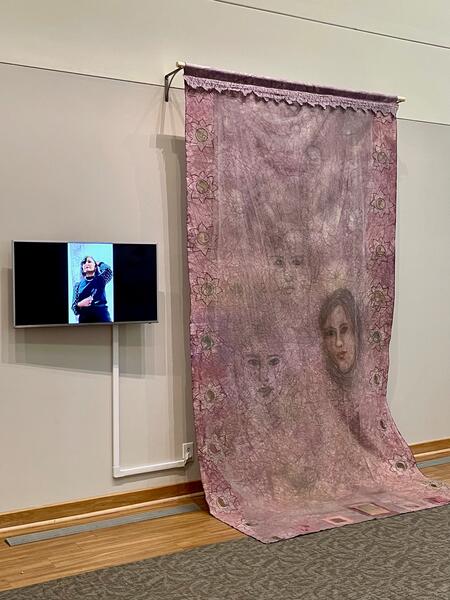 Installation view gallery shot at Irvine Arts Center, Fahimeh Vahdat Protest Performance: Cutting Off My Hair, Women, Life, Freedom Movement, 2022
Installation view gallery shot at Irvine Arts Center, Fahimeh Vahdat Protest Performance: Cutting Off My Hair, Women, Life, Freedom Movement, 2022This mixed media installation with the video showing the performance cutting my hair off has been shown twice since last year. Currently, it is in Irving Art Center, in Irving, Texas in a group exhibition and will be moved for another exhibition in the Fort Worth area in February. The work is entitled, From Mona to Masha form "Get your Power Back" series. 13'X7', Hand dyed canvas, sheer fabrics and lace, etchings and drawing materials, 2019-2022.
-
 Prior to Protest Performance, Cutting Off My Hair, Emotional, Empowering, Social ChangeGiving a talk to the college students at MIAD, Milwaukee about the work behind me, which is entitled, From Mona to Masha form "Get your Power Back" series prior to my protest performance cutting my hair off in mourning but also for solidarity to the Women, Life, Freedom uprising in Iran, September 28, 2022, only a week after the killing of Masha Amini by the morality police for improper hijab. 13'X7', Hand-dyed canvas, sheer fabrics and lace, etchings and drawing materials, 2019-2022.
Prior to Protest Performance, Cutting Off My Hair, Emotional, Empowering, Social ChangeGiving a talk to the college students at MIAD, Milwaukee about the work behind me, which is entitled, From Mona to Masha form "Get your Power Back" series prior to my protest performance cutting my hair off in mourning but also for solidarity to the Women, Life, Freedom uprising in Iran, September 28, 2022, only a week after the killing of Masha Amini by the morality police for improper hijab. 13'X7', Hand-dyed canvas, sheer fabrics and lace, etchings and drawing materials, 2019-2022. -
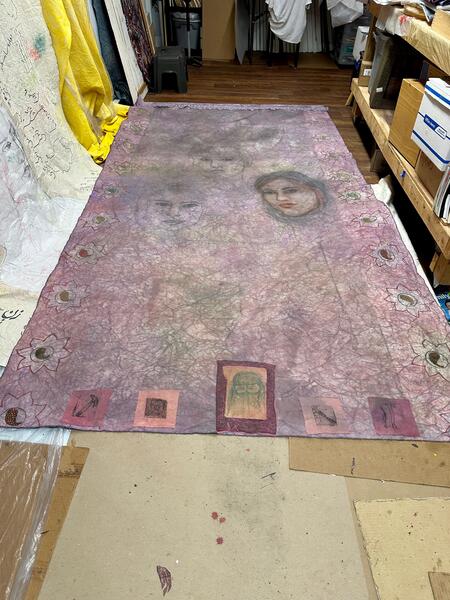 Progress shot for Fahimeh Vahdat Protest Performance: Mahsa Amini
Progress shot for Fahimeh Vahdat Protest Performance: Mahsa Amini -
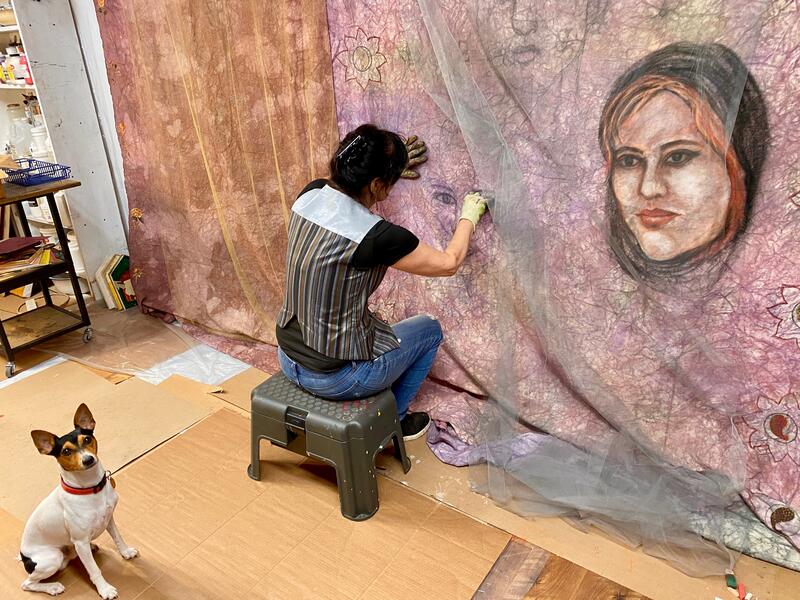 In Studio Shot for Fahimeh Vahdat Protest Performance: Cutting Off My Hair, Women, Life, Freedom Movement, 2022
In Studio Shot for Fahimeh Vahdat Protest Performance: Cutting Off My Hair, Women, Life, Freedom Movement, 2022 -
Fahimeh Vahdat My Hand Dying Process using Indian Vegetable Dyes
-
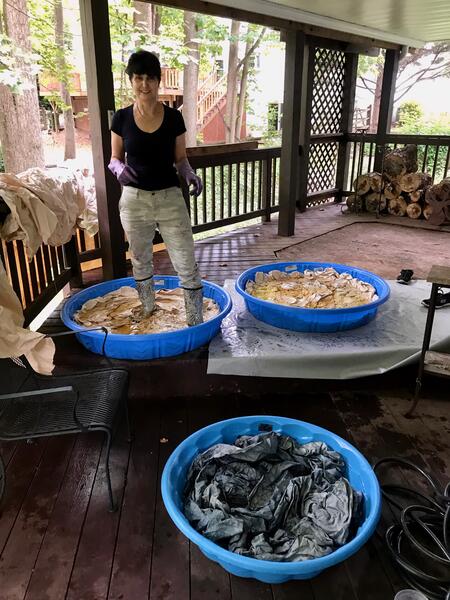 My hand dying process using Indian Vegetables dyes on large canvass
My hand dying process using Indian Vegetables dyes on large canvass
Sacred Crossings, A Memorial Tribute, Multi-Disciplinary Media Installation, Dallas, Milwaukee & West Virginia
This multimedia memorial tribute installation is comprised of a wooden edifice (12'X10'X8'), 215 wooden memorial grave markers which each digitally manipulated, and hand printed on an etching press, a video looping the film: Angle of Iran, looping chanting music in the gallery, 215 white roses, candle and rose water, the act of one removing their shoes entering the edifice and a Persian rug. It is a memorial tribute to the 215 people who were executed in Iran after the revolution of 1979 solely for their beliefs in Baha'i faith.This piece has a center edifice that shrines the images of 10 young women who were hanged in Shiraz, Iran publicly on June 18, 1983. One of them was my second cousin Tahireh, 32. In this installation I have used digitized printing method using etching press on Chiri paper mounted on varnished wood for keeping them archival. Chanting music, Rose water, removing one's shoes entering the edifice, a Persian rug in the center of it and 215 white roses laid down across the edges of the exhibition space was intended to create a sacred space for those innocent women, men, young and old who lost their lives for their faith. My uncle Mr. Vahdat who was 80 years old was executed and his wife was given 100 slashes that made her paralyzed for the rest of her life. The atrocities against Baha'is in Iran have continued to this day. The UN resolution has recently called for Government of Iran change its policies toward systematic imprisonment and continuous civil and personal abuses against the Baha'is who are the largest religious minorities in Iran. This body of work which was extensively researched to collect accurate documents and photographs started in 1992 and was completed in 1995 received partial support from Andy Warhol Foundation and NEA regional grants. It has been exhibited in Dallas, Milwaukee, and West Virginia. The act of laying down white roses each time this installation has been exhibited is a heartbreaking reminder that those 215 people were denied of any given memorial by their families.
-
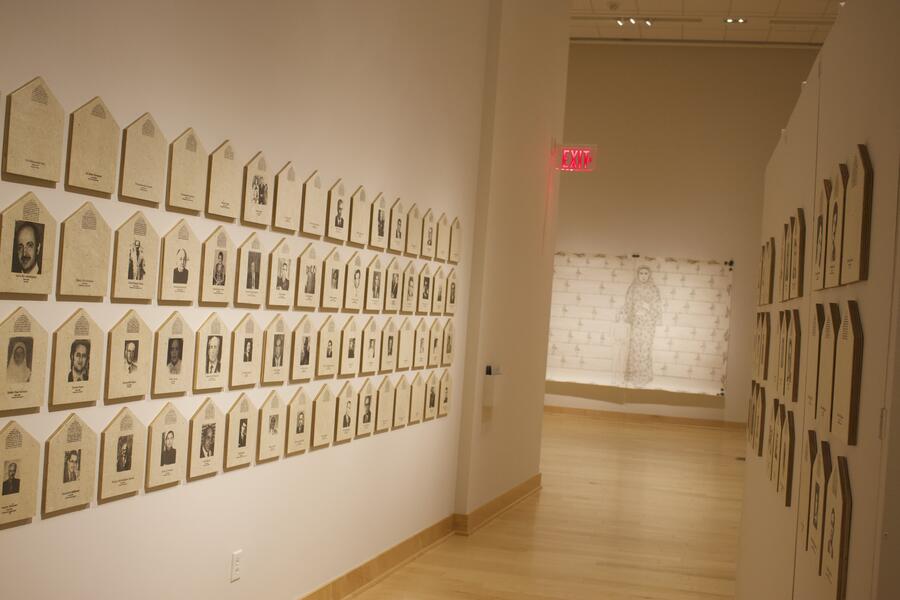 From "Sacred Crossings" - Two Great Walls
From "Sacred Crossings" - Two Great WallsThis is a multimedia installation dedicated to the 215 people who were executed in Iran after the revolution of 1979 in Iran solely for their Baha'i faith. This piece has a center edifice that shrines the 10 young women who were hanged in Shiraz, Iran publicly on June 1983. One of them was my second cousin Tahireh. In this installation I have used digitized printing method on Chiri paper mounted on varnished wood for keeping them archival. Sound, Rose water, removing one's shoes entering the edifice, a Persian rug in the center of it and 215 white roses across the exhibition space was intended to create a sacred space for those who lost their lives for their faith.
-
Sacred Crossings - A Memorial Tribute, Central Edifice for 10 Young Women Hanged in Shiraz, June 18, 1983The ceiling of the edifice in the Sacred Crossing installation which was constructed of a 12' X8' X10' has 10 roses hanged to honor the ten young Baha'i women who were hanged publicly in Shiraz, Iran solely for not recanting their faith on June 18, 1983. One of these ten women was my second cousin, Tahireh who was a volunteer nurse in rural parts of Shiraz. The fabric to cover the ceiling has screen printed words Iran and America in Persian. A bitter reminiscent of the supporting role USA played in bringing the brutal Islamic regime of Iran to power in 1979.
-
 Sacred Crossings Multi Media Installation - Inside the edifice, 12' x 8' x 10'215 white roses solemnly were laid down along side of the exhibition floor and 10 roses were hanged inside the edifice as a tribute to the 10 young women hanged in Shiraz for not recanting their Baha’i faith. The act of laying down white roses each time this installation has been exhibited was a heartbreaking reminder that those 215 people were denied of any given memorial by their families.
Sacred Crossings Multi Media Installation - Inside the edifice, 12' x 8' x 10'215 white roses solemnly were laid down along side of the exhibition floor and 10 roses were hanged inside the edifice as a tribute to the 10 young women hanged in Shiraz for not recanting their Baha’i faith. The act of laying down white roses each time this installation has been exhibited was a heartbreaking reminder that those 215 people were denied of any given memorial by their families. -
Sacred Crossings: A Tribute - Installation View
-
Sacred Crossings, A Memorial TributeThis is a multimedia installation dedicated to the 215 people who were executed in Iran after the revolution of 1979 in Iran solely for their Baha'i faith belief. This piece has a center edifice that shrines the 10 young women who were hanged in Shiraz, Iran publicly in June 1983. One of them was my second cousin Tahireh, 32. In this installation I have used digitized printing method on Chiri paper, printed on an etching press, mounted on varnished wood for keeping them archival. Sound, Rose water, removing one's shoes entering the edifice, a Persian rug in the center of it and 215 white roses across the exhibition space was intended to create a sacred space for those who lost their lives for their faith.
-
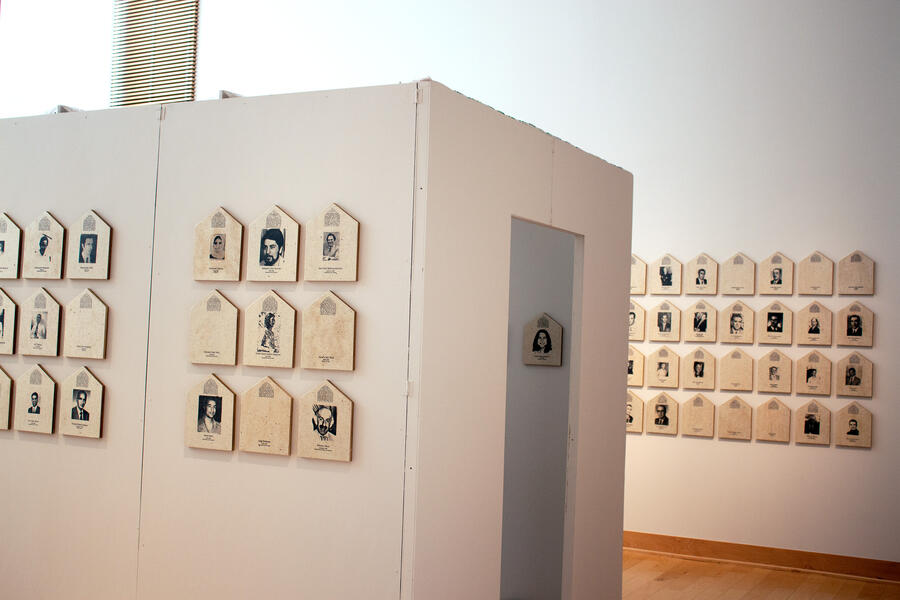 Sacred_Crossing_1.jpg
Sacred_Crossing_1.jpgA memorial dedicated to the Baha'is who were killed in Iran after 1979. The Baha'is have no civil rights under the current government. They are outlawed to practice their faith.
-
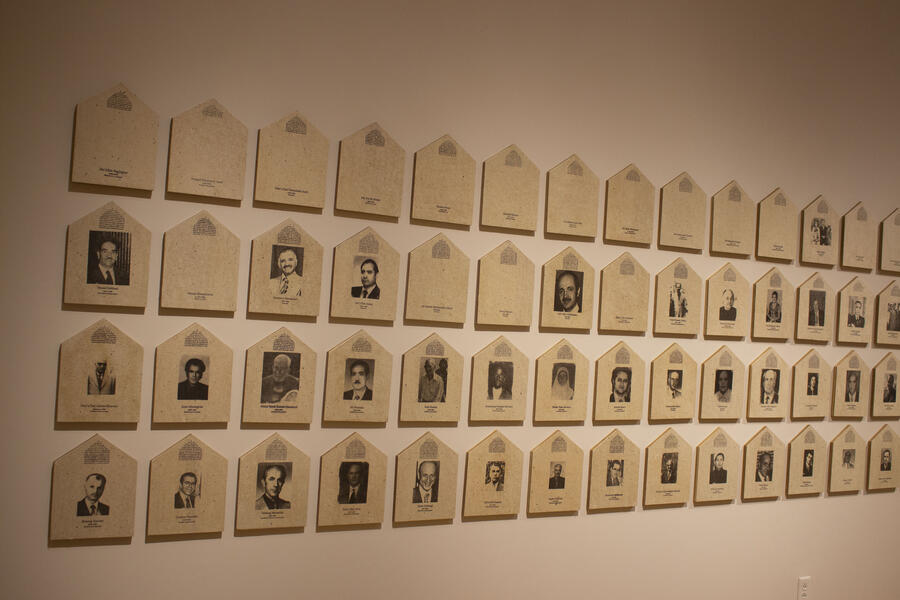 Sacred Crossings-great wall_1.jpg
Sacred Crossings-great wall_1.jpgInstallation view
-
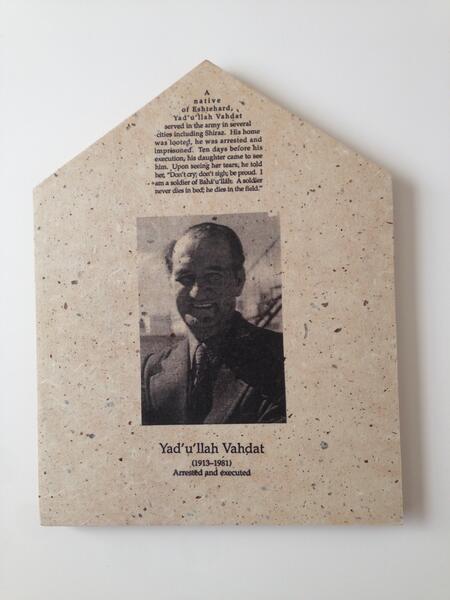 Sacred Crossings - My Uncle- Mr. VahdatMy great uncle, Mr. Yadulla Vahdat, was executed in Shiraz Iran on June 1981. His only crime was that he was a Baha'i and enttiled: father of the poor by people of Shiraz for his generosity to people. He was 80 years old.
Sacred Crossings - My Uncle- Mr. VahdatMy great uncle, Mr. Yadulla Vahdat, was executed in Shiraz Iran on June 1981. His only crime was that he was a Baha'i and enttiled: father of the poor by people of Shiraz for his generosity to people. He was 80 years old. -
 Sacred Crossings -Cental Edifice
Sacred Crossings -Cental Edifice
Facing the Wall, A performance in response to my Censored work entitled: A Prison Called Iran
A performance in response to my Censored work entitled: A Prison Called Iran.
From the "Freedom" series: A Prison called Iran” is the title of my work at this exhibition; it has been turned to the wall due to its content. This mixed media ten feet tall painting on hand-dyed canvas, metaphorically, represents a contour drawing of a standing nude woman with supplicating hands in a prison cell in Iran while flower motifs on her feet symbolizes hope and freedom. This piece represents the women who are in prison cells in Iran, as prisoners of conscience, whose voices are not heard by the outside world. At the same time, my voice as an artist is also not being heard due to censorship here in Milwaukee, WI. On June 16th, when I physically turned this piece to face the wall, I was overwhelmed with emotions and felt that I literally became the woman in a prison cell in Iran who faces walls all around her every day without the outside world hearing her voice.
-
Fahimeh_Vahdat Facing_the_Wall
n 2011, my piece, entitled "A prison called Iran," was included in a group exhibition at a gallery in Downtown Milwaukee. However, I was later informed that my work would need to be removed due to its content. In response to this censorship, I staged a public performance at the opening reception where I turned my painting to face the wall in protest.
-
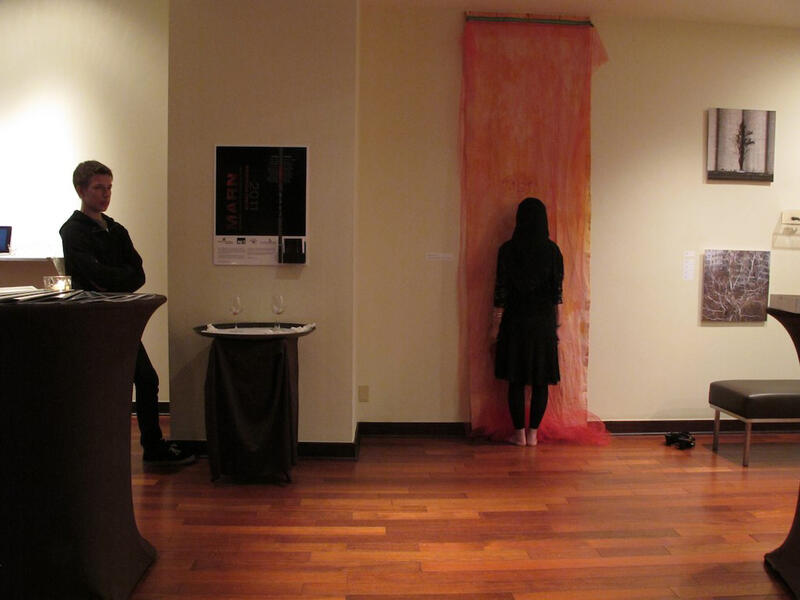 Facing the Wall Protest Performance 2011I faced the wall against my painting, which was turned facing the wall as well. I stood in the same position without moving in total silence for an hour while the reception for the exhibition was going on. I gave a short talk to the large crowd before my performance.
Facing the Wall Protest Performance 2011I faced the wall against my painting, which was turned facing the wall as well. I stood in the same position without moving in total silence for an hour while the reception for the exhibition was going on. I gave a short talk to the large crowd before my performance. -
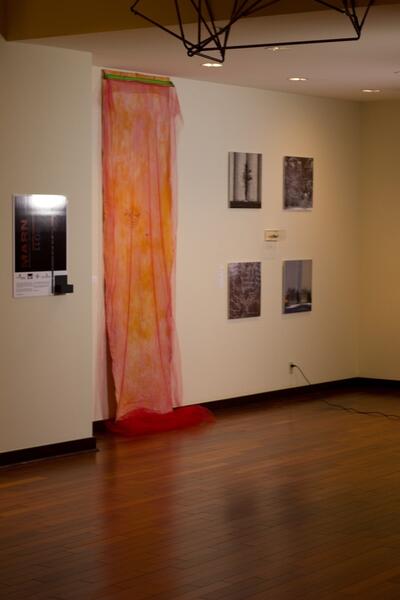 Facing the Wall Protest Performance 2011Please watch the video to see the performance and the painting as well. In 2012 I was invited to exhibit this work in a gallery in Milwaukee with two other artists whose works were also censored many years ago in Wisconsin.
Facing the Wall Protest Performance 2011Please watch the video to see the performance and the painting as well. In 2012 I was invited to exhibit this work in a gallery in Milwaukee with two other artists whose works were also censored many years ago in Wisconsin. -
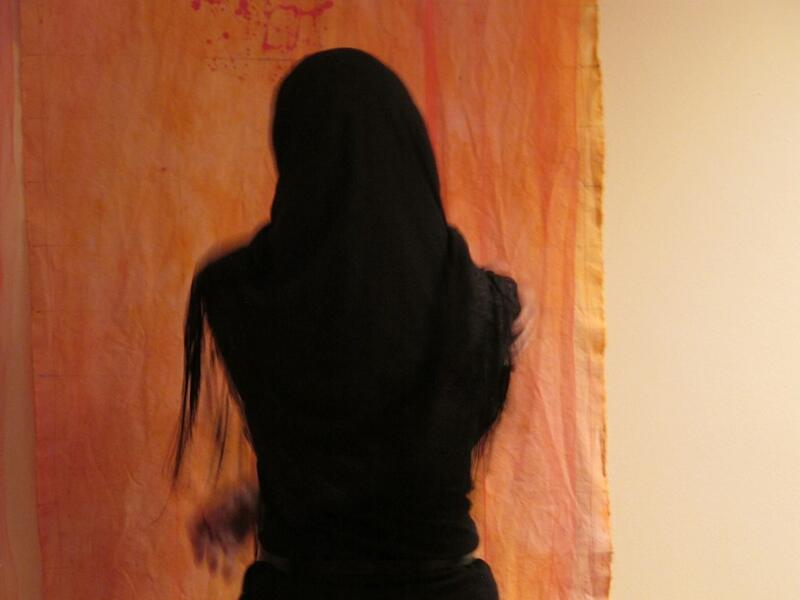 Facing the Wall Protest Performance 2011Why is it facing the wall? Is it a new thing to be censored in this country? When does the public have the right to freedom of expression? Censorship takes place in all levels of society, but not mostly by the public. Rather, censorship takes place by those who make decisions about what kind of art should be seen or not. I believe the public should not be deprived of the opportunity to have exchange of ideas over issues that are current and urgent, and to see works of art that can open the dialogue and lead to new awareness.
Facing the Wall Protest Performance 2011Why is it facing the wall? Is it a new thing to be censored in this country? When does the public have the right to freedom of expression? Censorship takes place in all levels of society, but not mostly by the public. Rather, censorship takes place by those who make decisions about what kind of art should be seen or not. I believe the public should not be deprived of the opportunity to have exchange of ideas over issues that are current and urgent, and to see works of art that can open the dialogue and lead to new awareness. -
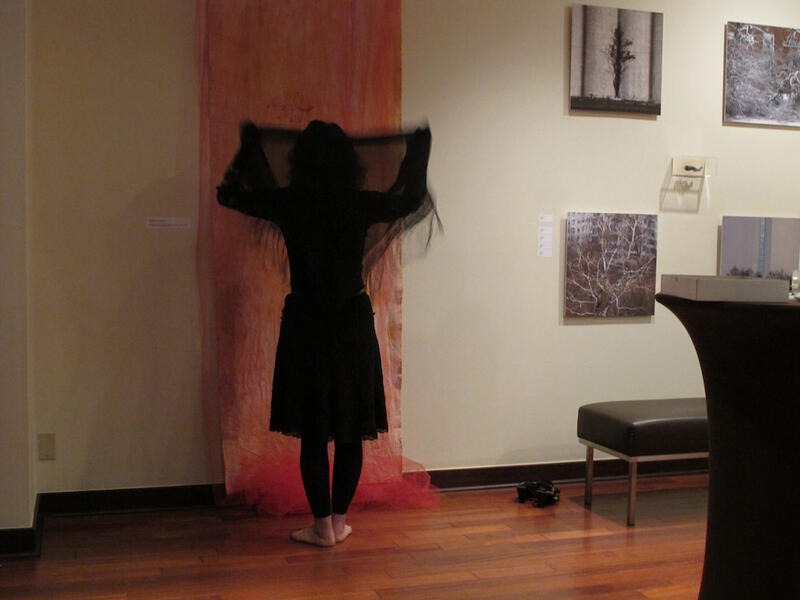 Facing the Wall Protest Performance 2011After my art was installed at a gallery in Downtown Milwaukee, 2011, I was told to remove my work from the group exhibition due to its content. The work was entitled: A prison called Iran. In response to this censorship, I turned my painting facing the wall and did a public performance at the opening reception.
Facing the Wall Protest Performance 2011After my art was installed at a gallery in Downtown Milwaukee, 2011, I was told to remove my work from the group exhibition due to its content. The work was entitled: A prison called Iran. In response to this censorship, I turned my painting facing the wall and did a public performance at the opening reception. -
 Facing the Wall Protest Performance 2011
Facing the Wall Protest Performance 2011 -
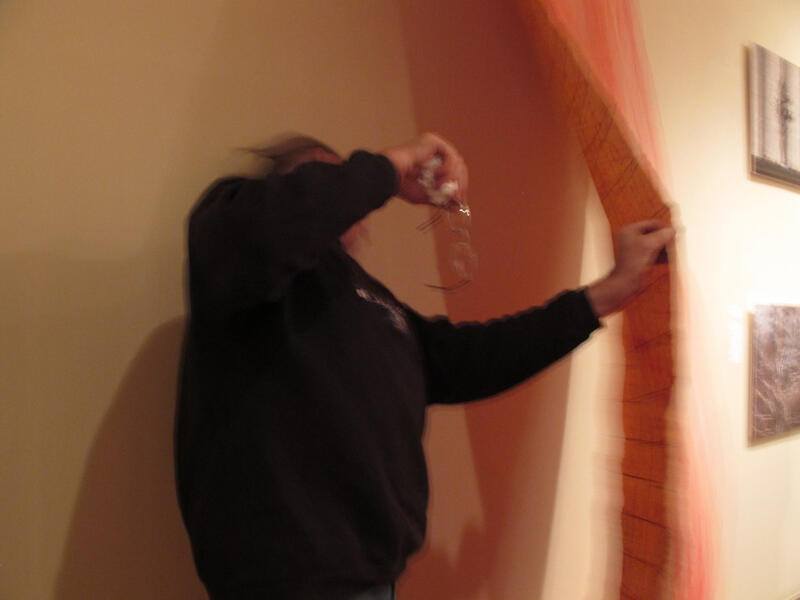 Facing the Wall Protest Performance 2011Of course, some people could not help themselves and had to steal a look at the work even the note on the wall explained why they only seeing the back of the painting.
Facing the Wall Protest Performance 2011Of course, some people could not help themselves and had to steal a look at the work even the note on the wall explained why they only seeing the back of the painting. -
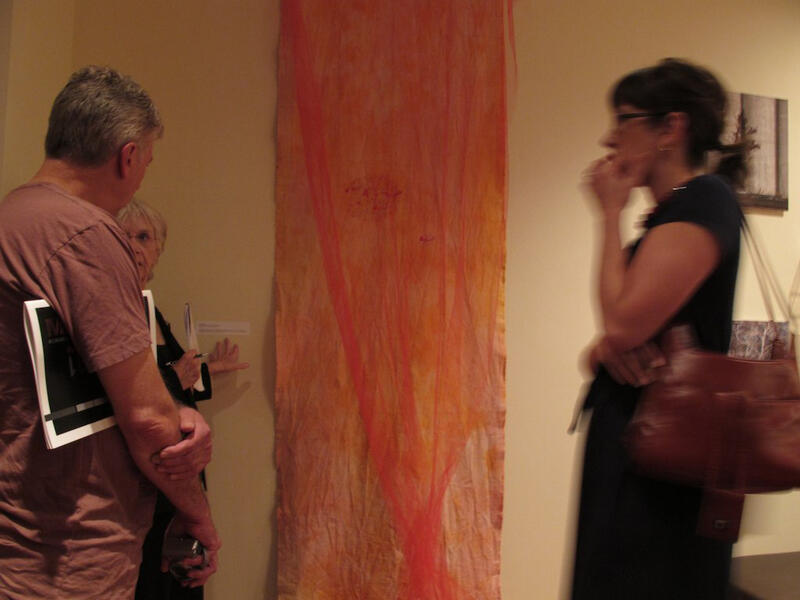 Facing the Wall Protest Performance 2011Discussion among the viewers at the reception.
Facing the Wall Protest Performance 2011Discussion among the viewers at the reception. -
 Facing the Wall, Censored Artwork: A Prison Called Iran, 10' X 5', Mixed Media, 2011This is my 10' X 5' censored artwork at the gallery M in Milwaukee, WI, 2011. In order not to remove my work from the exhibition and protest against the censorship in USA, I turned the piece facing the wall during the entire exhibition. The public did not get to see the artwork, but it brought many discussion about the topic. The vedio is too large to uploade on this site. Throughout the entire exhibition this work remained facing the wall and the public did not have a chance to view the actual artwork. This work and the act of censorship that took place in the gallery caused many discussion on social media and news paper on the right to free expression in the USA. This peice was performed in Baltimore in 2015.
Facing the Wall, Censored Artwork: A Prison Called Iran, 10' X 5', Mixed Media, 2011This is my 10' X 5' censored artwork at the gallery M in Milwaukee, WI, 2011. In order not to remove my work from the exhibition and protest against the censorship in USA, I turned the piece facing the wall during the entire exhibition. The public did not get to see the artwork, but it brought many discussion about the topic. The vedio is too large to uploade on this site. Throughout the entire exhibition this work remained facing the wall and the public did not have a chance to view the actual artwork. This work and the act of censorship that took place in the gallery caused many discussion on social media and news paper on the right to free expression in the USA. This peice was performed in Baltimore in 2015. -
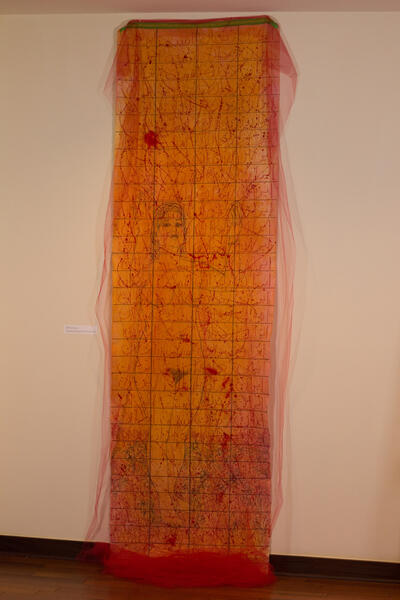 A Prison Called Iran Installation PerformanceThis painting entitled " A Prison Called Iran" was part of a group exhibition at Mgallery at the Intercontinental hotel in downtown Milwaukee. It was a part of a mentor mentee exhibition run by Marn. After the work was installed, they notified me that I must take my work down, or roll it up to the head of the drawing of the woman in the work. I decided to turn the work facing the wall of the gallery instead-- making a performance in protest of censorship during the reception.
A Prison Called Iran Installation PerformanceThis painting entitled " A Prison Called Iran" was part of a group exhibition at Mgallery at the Intercontinental hotel in downtown Milwaukee. It was a part of a mentor mentee exhibition run by Marn. After the work was installed, they notified me that I must take my work down, or roll it up to the head of the drawing of the woman in the work. I decided to turn the work facing the wall of the gallery instead-- making a performance in protest of censorship during the reception.
I am Iran I am America, A Site Specific Multi-Disciplinary Installation, Milwaukee Art Museum, 2010
A site specific and interactive mixed media installation at the Milwaukee Art Museum entitled: I am Iran I am America. This is the only art piece that I have made that symbolically deals with my journey from Iran to America 43 years ago, but this installation also dealt with the political relationship between USA and Iran and the continuation of executions of prisoners of conscious.
I was forced to leave Iran after its revolution of 1979 due to persecution of Baha’is and execution of three of my relatives. Since then, I have lived in Europe and then USA in exile. As an Iranian American artist, Women / human rights activist, and educator I have worked on various capacities to share my experience with other artists and the communities in which I live in. The 8'X8' round table is divided into two uneven halves representing my life living in USA for the past 43 years. Also, Iran is a much smaller country than USA, a superpower, but with continued divide and conflict between the two countries at least on the surface. The tyrannic regime lobbies with the West and in the region by faking the condition of people living in Iran especially women and girls in order to hold its power in the region and to do business with the West. The nuclear deal has come along five years after I completed this piece, but my view on the brutal regime of Iran has not changed. I opposed Iran to have nuclear power but also USA not to have any business deal behind peoples back.
This mixed media installation compromises of fabricated wood with almost invisible screen printing on the top surface of each section using the word Iran and America in Persian writing representing secret deals. The layers of fabric also are printed with the same text in the missing color of each country's flag. No negotiation, no sitting down for discussion around this divided and uneven round table.
The smaller three tired, red, and blue egg tempera painting represents my feet for taking the journey, which took 556 days to set foot to US soil. It also represents the execution of prisoners of conscience by hanging practices that takes place often and mostly in public places in various cities and towns in Iran.
-
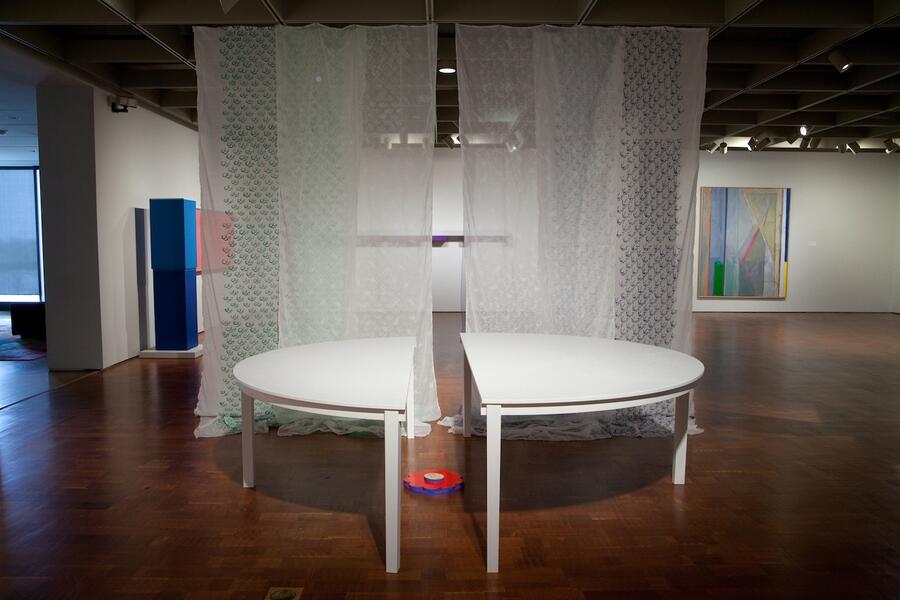 I am Iran I am America, Multi-Media and interactive Installation, 2010Frontal View, Fabricated Wood, screen printing on the severed table, Three-tiered Egg Tempera Painting on the floor, hanging Screen Printed Fabric and lace, Stacks of Hand Printed Papers,1"X4" for the Interactive Part of the Installation, (not shown), Milwaukee Art Museum, 2010. This site specific and interactive mixed media installation at the Milwaukee Art Museum is entitled, I am Iran I am America. The only artwork that I have made which symbolically deals with my difficult journey from Iran to America 43 years ago, but also deals with the most heinous crime the Islamic Republic of Iran has committed systematically and regularly since 1979 which is the executions of prisoners of conscience and children. The focus of this installation is on the political relationship or lack of between the USA and Iran. Both countries ignore the gross human rights violations that take place daily toward people of Iran especially women and girls under the patriarchal government.
I am Iran I am America, Multi-Media and interactive Installation, 2010Frontal View, Fabricated Wood, screen printing on the severed table, Three-tiered Egg Tempera Painting on the floor, hanging Screen Printed Fabric and lace, Stacks of Hand Printed Papers,1"X4" for the Interactive Part of the Installation, (not shown), Milwaukee Art Museum, 2010. This site specific and interactive mixed media installation at the Milwaukee Art Museum is entitled, I am Iran I am America. The only artwork that I have made which symbolically deals with my difficult journey from Iran to America 43 years ago, but also deals with the most heinous crime the Islamic Republic of Iran has committed systematically and regularly since 1979 which is the executions of prisoners of conscience and children. The focus of this installation is on the political relationship or lack of between the USA and Iran. Both countries ignore the gross human rights violations that take place daily toward people of Iran especially women and girls under the patriarchal government. -
 I Am Iran I Am AmericaInteractive installation at the Milwaukee Art Museum. Depicts the journey from Iran to the USA and suffering immigrants endured by the governmental policies from each country. Layers of hand printed fabrics symbolize American and Iranian flags and its shared colors red and white, but the only color varies in each flag is blue (USA) and Green (Iran). The emphasis is on similarities and not differences between the two countries! The 8'X8' round table fabricated which is divided unevenly invites the two countries for a face to face round table discussion.
I Am Iran I Am AmericaInteractive installation at the Milwaukee Art Museum. Depicts the journey from Iran to the USA and suffering immigrants endured by the governmental policies from each country. Layers of hand printed fabrics symbolize American and Iranian flags and its shared colors red and white, but the only color varies in each flag is blue (USA) and Green (Iran). The emphasis is on similarities and not differences between the two countries! The 8'X8' round table fabricated which is divided unevenly invites the two countries for a face to face round table discussion. -
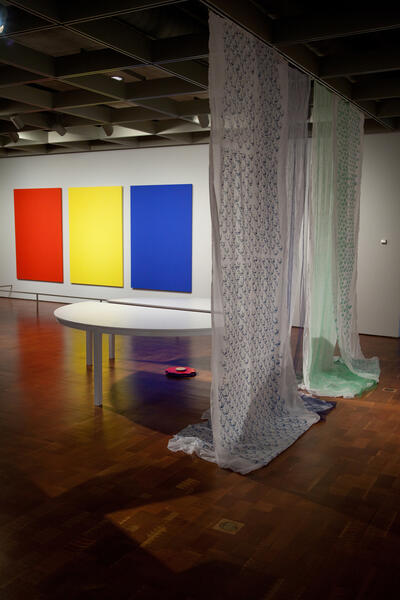 I am Iran I am AmericaDifferent view near Kelly's work.
I am Iran I am AmericaDifferent view near Kelly's work. -
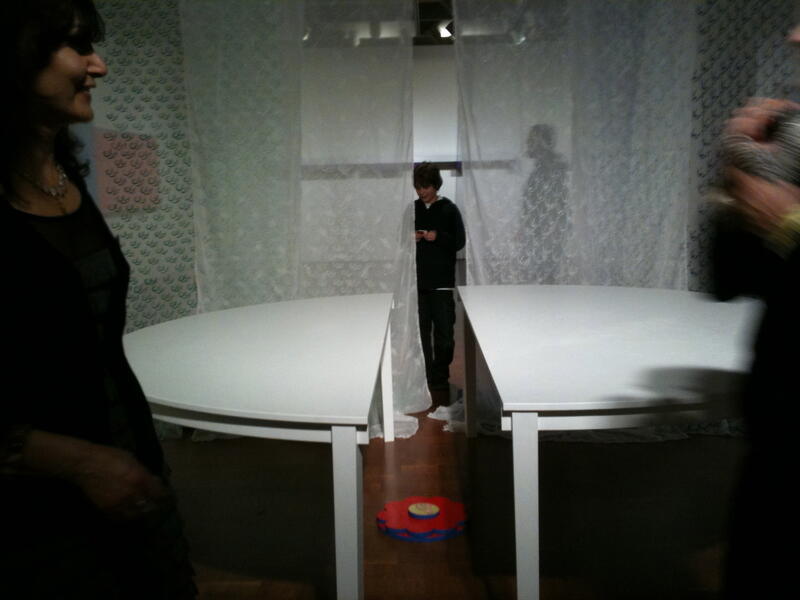 I am Iran I am AmericaInteractive installation with the audience and the viewer.
I am Iran I am AmericaInteractive installation with the audience and the viewer. -
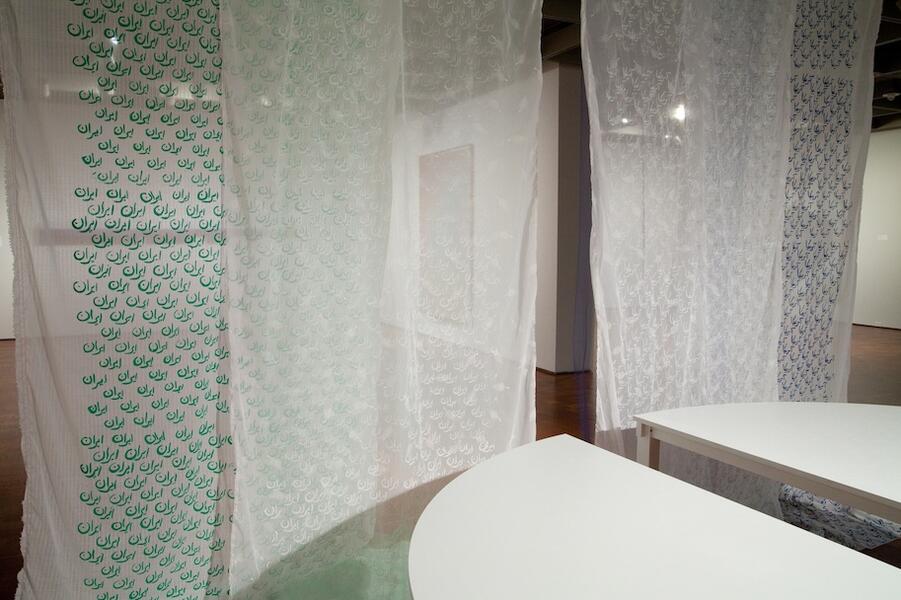 I am Iran I am AmericaDetail of the sheered hand printed Persian words Iran and America in the colors of each country's flag.
I am Iran I am AmericaDetail of the sheered hand printed Persian words Iran and America in the colors of each country's flag. -
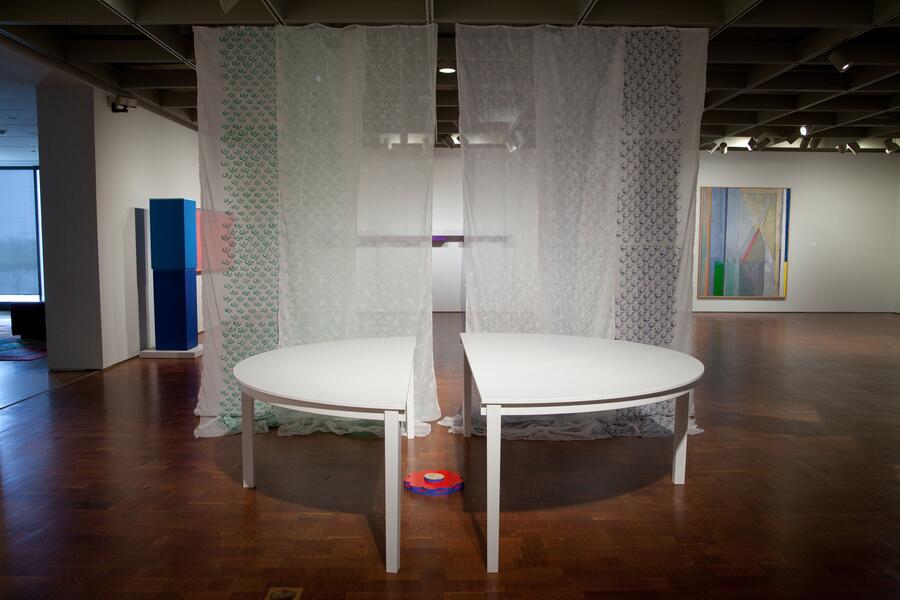 Detail: I am Iran I am AmericaThe 8 feet round table is unevenly severed with uneven height and printed surface with the persian word Iran and America, but sits bare in its space. This uneven design was purposefully chosen to represent two ideas: 1. The smaller part represents my former country of Iran that I have spent less time there, before fleeting to seek religious asylum in USA as is represented by the larger part of the design. 2. This is a round table for meetings, but there is no negotiation or no deal on the table with these two countries (yet)!
Detail: I am Iran I am AmericaThe 8 feet round table is unevenly severed with uneven height and printed surface with the persian word Iran and America, but sits bare in its space. This uneven design was purposefully chosen to represent two ideas: 1. The smaller part represents my former country of Iran that I have spent less time there, before fleeting to seek religious asylum in USA as is represented by the larger part of the design. 2. This is a round table for meetings, but there is no negotiation or no deal on the table with these two countries (yet)! -
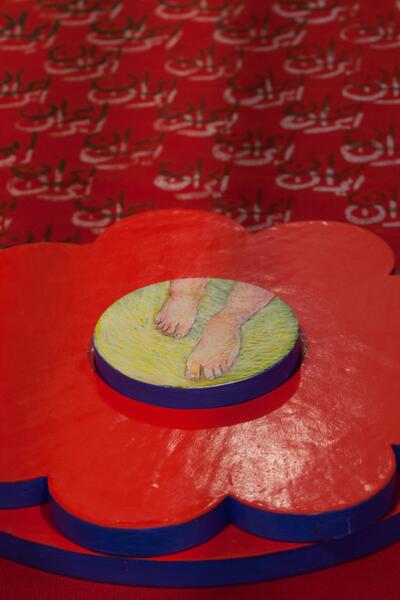 I am Iran I am AmericaThis three tiers egg tempera on wood and screen print on felt, is the center piece for this installation, which has two folds: one is about my journey from Iran to America and the other deals with the public executions in Iran, which are mostly by hanging.
I am Iran I am AmericaThis three tiers egg tempera on wood and screen print on felt, is the center piece for this installation, which has two folds: one is about my journey from Iran to America and the other deals with the public executions in Iran, which are mostly by hanging. -
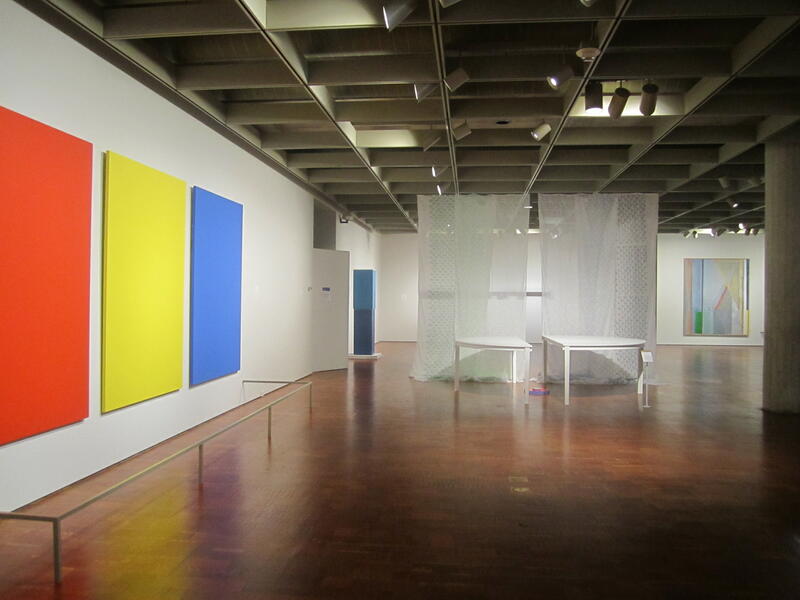 I am Iran I am AmericaInstallation shot, Mixed media site specific installation, Milwaukee Art Museum, 2010.
I am Iran I am AmericaInstallation shot, Mixed media site specific installation, Milwaukee Art Museum, 2010. -
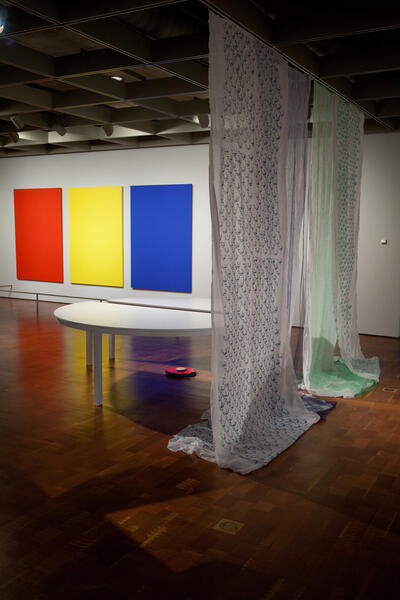 I am Iran I am AmericaI am Iran I am America Installation View at Milwaukee Art Museum
I am Iran I am AmericaI am Iran I am America Installation View at Milwaukee Art Museum -
 I am Iran I am AmericaInstallation in progress.
I am Iran I am AmericaInstallation in progress.
One Million Signiture Campaign: from the "Freedom" series
This 15'X7', two-sided (it was made to walk around the piece), hand dyed canvas with many layers of sheer fabrics and monotype prints of notable imprisoned women is a testimonial piece for resistance against tyrannical civil laws imposed on women in Iran since 1979. Living in exile in the free world, my work focuses on human rights abuses, violence against women and girls and the prison systems especially in Iran and the Middle East. I often compare the violence against women and girls within the USA and how it differs. It is ironic as we have entered the age of technological advances on many levels as humans, we still witness human rights violation and lack of freedom and democracy in its pandemic state in many countries around the world. Does violence against women and girls goes under rug by the notion of culture stamped by the West in many countries around the world such as Afghanistan and Iran?
For example, in the body of work entitled: “Protest"; from my ongoing “Freedom” series, I examine the notion of peaceful protest especially since 2009 and its effect to bring positive changes around the world. Of course, we must note the historic 1963 March on Washington, and the “I have a Dream” peaceful protest led by Dr. Martin Luther King Jr. and how it has changed the courses of the history of a nation, but also, positively the lives of millions of people.
Since 2006 many courageous women in Iran have launched a “One Million-Signature Campaign” demanding changes to discriminatory civil laws against women's rights in Iran. Women in Iran and other Middle Eastern countries continue to protest to demand equal rights to the existing civil and social discriminatory laws.
In support of “One Million Signatures Campaign” since 2007, I have used the single word in Persian “Khodaya” which means “O God” which is not a religious term in Persian language but rather an everyday word which sometimes used for supplication to represent a signature. I will continue to repeat this word over and over in various work until it adds up to one million signature (near 500,000 so far) as a testimonial for the solidarity with the women in Iran and their worthy cause.
For example, in the body of work entitled: “Protest"; from my ongoing “Freedom” series, I examine the notion of peaceful protest especially since 2009 and its effect to bring positive changes around the world. Of course, we must note the historic 1963 March on Washington, and the “I have a Dream” peaceful protest led by Dr. Martin Luther King Jr. and how it has changed the courses of the history of a nation, but also, positively the lives of millions of people.
Since 2006 many courageous women in Iran have launched a “One Million-Signature Campaign” demanding changes to discriminatory civil laws against women's rights in Iran. Women in Iran and other Middle Eastern countries continue to protest to demand equal rights to the existing civil and social discriminatory laws.
In support of “One Million Signatures Campaign” since 2007, I have used the single word in Persian “Khodaya” which means “O God” which is not a religious term in Persian language but rather an everyday word which sometimes used for supplication to represent a signature. I will continue to repeat this word over and over in various work until it adds up to one million signature (near 500,000 so far) as a testimonial for the solidarity with the women in Iran and their worthy cause.
-
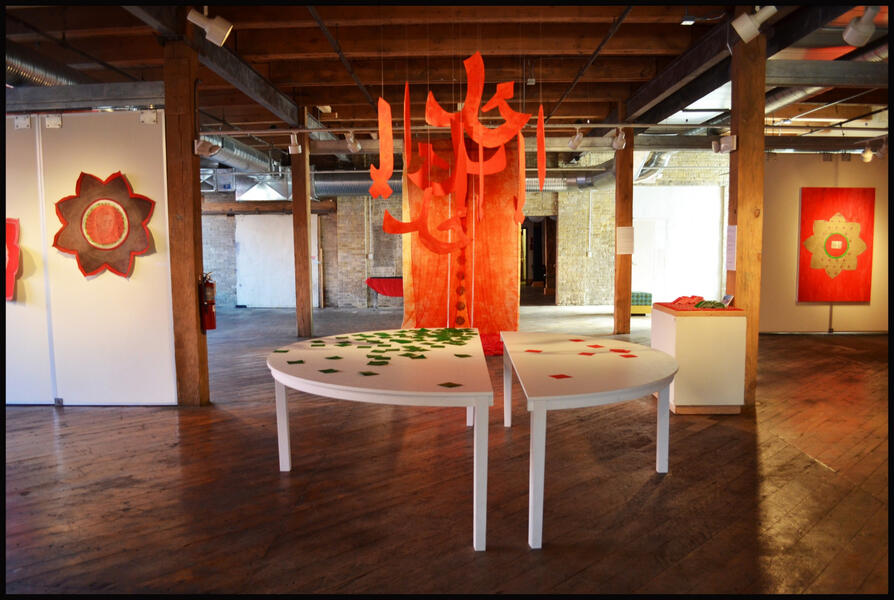 From "Freedom" series, Vote: for or against USA wages War on IranThis interactive mixed media installation was set up in a way that the viewers would silently choose a ballot to cast their votes for yes (Red cards) and no (Green cards) on the question: Should USA wages war against Iran or not? This question continues through 2019! This exhibition was up during the presidential election in USA, 2012.
From "Freedom" series, Vote: for or against USA wages War on IranThis interactive mixed media installation was set up in a way that the viewers would silently choose a ballot to cast their votes for yes (Red cards) and no (Green cards) on the question: Should USA wages war against Iran or not? This question continues through 2019! This exhibition was up during the presidential election in USA, 2012. -
 One Million Signiture Campaign: from "Freedom" seriesThis mixed media two- sided print and painting installation is 250" X 90". The central piece has monotype printed images of women prisoners of conscience in Evin prison, Tehran, Iran who have helped with this campaign. Also the Persian word has been repeatedly written all over the work signifying signatures collected by people for this cause. Hand-dyed canvas, fabric, sweing, thread and metal
One Million Signiture Campaign: from "Freedom" seriesThis mixed media two- sided print and painting installation is 250" X 90". The central piece has monotype printed images of women prisoners of conscience in Evin prison, Tehran, Iran who have helped with this campaign. Also the Persian word has been repeatedly written all over the work signifying signatures collected by people for this cause. Hand-dyed canvas, fabric, sweing, thread and metal -
 From "Freedom" Series: One Million Signature CampaignThe title of this large work is: One Million Signature Campaign.This very large piece took over two years to complete. It is made out of hand-dyed canvas, layers of fabrics sewed together, Montotype printed images of activist women in Evin prison in Iran, lace, ink and several thousands of hand written Persian word: "Khodaya" which is a secular and supplicating word meaning "Oh God" in English resembling individual signature collected to support this cause.
From "Freedom" Series: One Million Signature CampaignThe title of this large work is: One Million Signature Campaign.This very large piece took over two years to complete. It is made out of hand-dyed canvas, layers of fabrics sewed together, Montotype printed images of activist women in Evin prison in Iran, lace, ink and several thousands of hand written Persian word: "Khodaya" which is a secular and supplicating word meaning "Oh God" in English resembling individual signature collected to support this cause. -
 Detail: One Million Signituare CampaignThe images of some of the women who have been imprisoned helping out with this campaign have been printed on the central panel. The central panel has been cut but attached only from the top to represent prison and isolation.
Detail: One Million Signituare CampaignThe images of some of the women who have been imprisoned helping out with this campaign have been printed on the central panel. The central panel has been cut but attached only from the top to represent prison and isolation. -
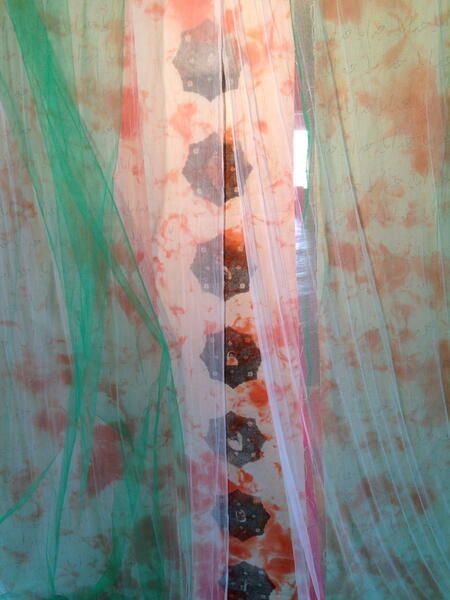 Detail: One Million Signituare CampaignThis campaign is for collecting one million signatures in the hope of changing the discriminatory civil laws set by the government against women in Iran. The images of some of the women who have been imprisoned helping out with this campaign have been printed on the central panel. The central panel has been cut but attached only from the top to represent prison and isolation.
Detail: One Million Signituare CampaignThis campaign is for collecting one million signatures in the hope of changing the discriminatory civil laws set by the government against women in Iran. The images of some of the women who have been imprisoned helping out with this campaign have been printed on the central panel. The central panel has been cut but attached only from the top to represent prison and isolation. -
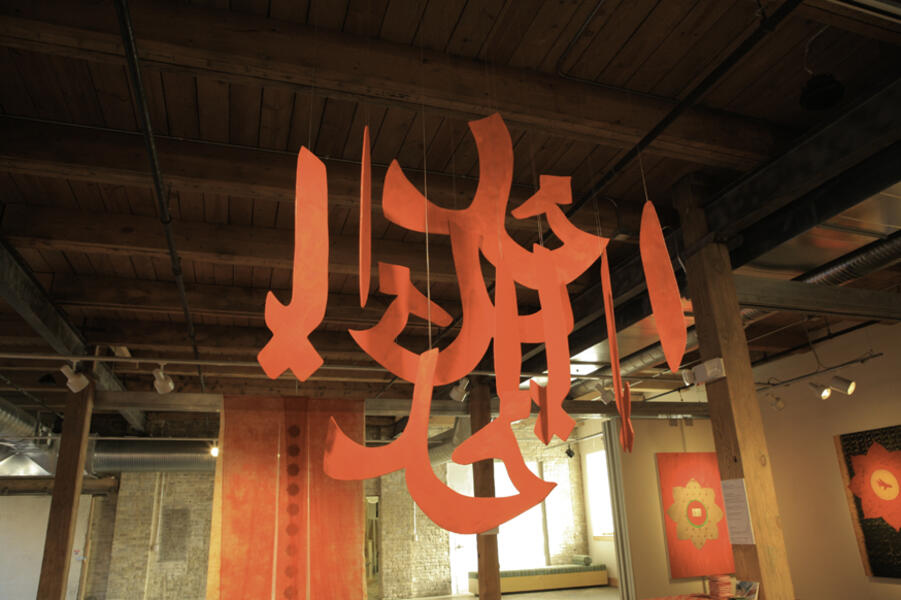 Protest, from the"Freedom; seriesIn this mixed Media interactive installation, I have used the word "Oh God" repeatedly in various forms in Persian that signifies a signature for this campaign. Cast Your Vote: For or against USA wages War on Iran is a part of this installation that is visible in this image.
Protest, from the"Freedom; seriesIn this mixed Media interactive installation, I have used the word "Oh God" repeatedly in various forms in Persian that signifies a signature for this campaign. Cast Your Vote: For or against USA wages War on Iran is a part of this installation that is visible in this image. -
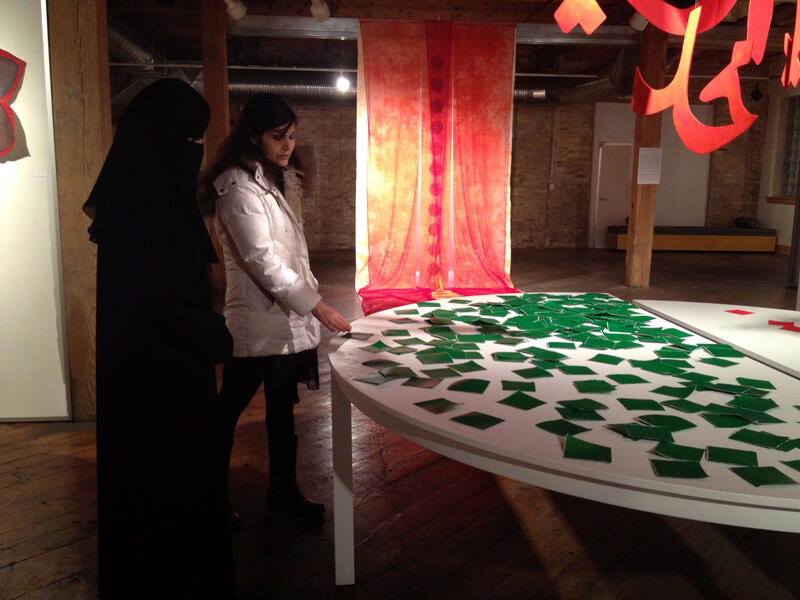 One Million Signature CampaignThe viewer is casting (green) vote for USA not to wage war on Iran during the presidential election 2012. Also a viewer has participated in the Change+ing Room interactive installation, which allows participant wearing veil and burka to experience how it feels to wear one in public space (the gallery).
One Million Signature CampaignThe viewer is casting (green) vote for USA not to wage war on Iran during the presidential election 2012. Also a viewer has participated in the Change+ing Room interactive installation, which allows participant wearing veil and burka to experience how it feels to wear one in public space (the gallery). -
 One Million Signature Campaign: from "Freedom"serieshis mixed media two- sided print and painting installation is 250" X 90". The central piece has printed images of women prisoners of conscience in Evin prison, Tehran, Iran who have helped with this campaign. Also the Persian word has been repeatedly written all over the work signifying signatures collected by people for this cause.
One Million Signature Campaign: from "Freedom"serieshis mixed media two- sided print and painting installation is 250" X 90". The central piece has printed images of women prisoners of conscience in Evin prison, Tehran, Iran who have helped with this campaign. Also the Persian word has been repeatedly written all over the work signifying signatures collected by people for this cause. -
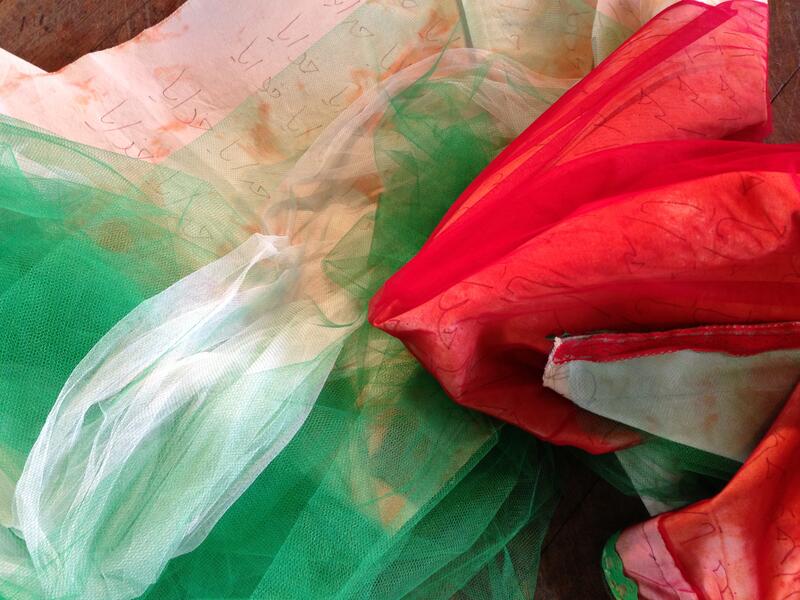 One Million Signituare CampaignDetail
One Million Signituare CampaignDetail -
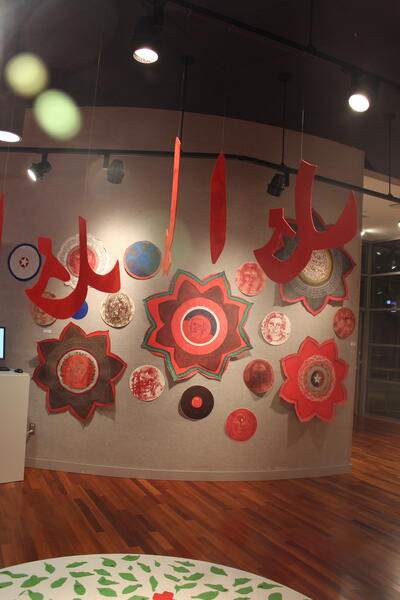 From "Freedom" series, Vote: for or against USA wages War on Iran
From "Freedom" series, Vote: for or against USA wages War on Iran
A complex series of researched based large scale drawings entitled: What Will Befall Her?
“What Will Befall Her?” is a series of large scale charcoal drawings on hand made Korean paper. Each image depicts female figures often against a backdrop of symbolic imagery and text and if not space employed is flat and stark. Some texts used in these images are from contemporary Iranian political poets in Persian calligraphy. Also, the drawings are designed in the persian carpet format which represents garden of paradise which traditionally is filled with colorful flowers, but in these drawings (Persian gardens) the color has been intentionally restricted to black and white, at once symbolizing the oppression, and stripping the work its to essential imagery and content.
The flowers and patterns used in these works are chosen very carefully to symbolize various topics related to women and girls. For example; lilies represent purity, innocence and essence of life where a little girl is standing on the sea of lilies in “What Will Befal Her?”, or the Alchemical roses in the borders of “ The Dishonor of War” is an ancient female symbol of the virgin daughter within the mother which contains female creative power. In “Women Are Not For Burning” the uprooted saffron flowers which is a religious / wedding ceremonial incense represent the bride burning in India in order to collect dowry. The fire flower used on the border of this work also represents the essential gift of the Goddess's of love and the palm tree represent male force. Iris is the messenger of heaven sent to gather up the souls of women. In the border of “The Fallen” which is a 20 feet long drawing the oak tree leaves represent power.
The scale which is a primary factor puts the viewer into a one to one relationship with the images. The images confront the viewer, yet do not overwhelm, but do command attention and space. The women are nude, as the intent is to show them without the "veils" of restrictions, assumptions, and cultural roles. The nobility of women stands out in the plain, bold and simple statement of contour line drawing on paper. I exhibit the work in installation format, employing the physical space of various venues to direct the viewer’s interactions with these images. Each drawing stands on its own, yet, the dynamic created when ten or more of these images are viewed simultaneously is quite impacting.
-
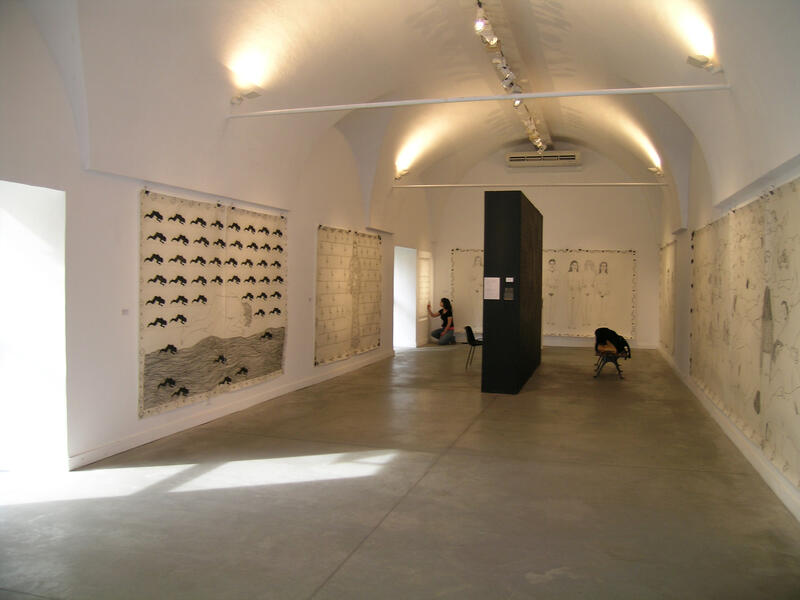 What Will Befall Her?This exhibition was at Recoleta Art Center in Argentina with Hemispheric Institute, NYC. 2007
What Will Befall Her?This exhibition was at Recoleta Art Center in Argentina with Hemispheric Institute, NYC. 2007 -
What Will Befall Her?This work is entitled: Women Are Not for Burning is an homage to Men Are Not for Burning, but also a reference to bride burning which still is a wide spread crime in parts of India. 7'X10', Charcoal on hand-made Korean paper.
-
From "What Will Befall Her?" Series, Exhibition shot"The Slaughter of the Innocent" is a Charcoal drawing from " What Will Befall Her" Series that deals with millions of human embrios which have been aborted based on their gender. of being girls especially in China and India over many decades. The shortage of women and girls in these countries is alarming now due to those hidden criminal abortions.
-
How many Wives? from the "What Will Befall Her?" series,This piece is called: How Many Wives, in reference to pleasure marriage which is legalized after the revolution of 1979 in Iran and other parts of Middle East. Alos is a direct realization to under aged marriage of girls ages 11 to 16. 7'X10'
-
 Where Is Justice? From "What Will Befall Her?" SeriesWhere is Justice? is the title of this 15 feet wide drawing depicting women from all backgrounds dealing with domestic violence from the "What Will Befall Her?" series, Charcoal on hand-made Korean Paper. 7' X 15'
Where Is Justice? From "What Will Befall Her?" SeriesWhere is Justice? is the title of this 15 feet wide drawing depicting women from all backgrounds dealing with domestic violence from the "What Will Befall Her?" series, Charcoal on hand-made Korean Paper. 7' X 15' -
 What Will Befall Her?This 20 feet by 10 feet drawing entitled: The Fallen, depict a little girl standing in front of a massive number of women who have been victim of violence against them is from the "What Will Befall Her?" series, Charcoal on hand-made Korean Paper. This work symbolically addresses the ongoing violence against women and girl around the world.
What Will Befall Her?This 20 feet by 10 feet drawing entitled: The Fallen, depict a little girl standing in front of a massive number of women who have been victim of violence against them is from the "What Will Befall Her?" series, Charcoal on hand-made Korean Paper. This work symbolically addresses the ongoing violence against women and girl around the world. -
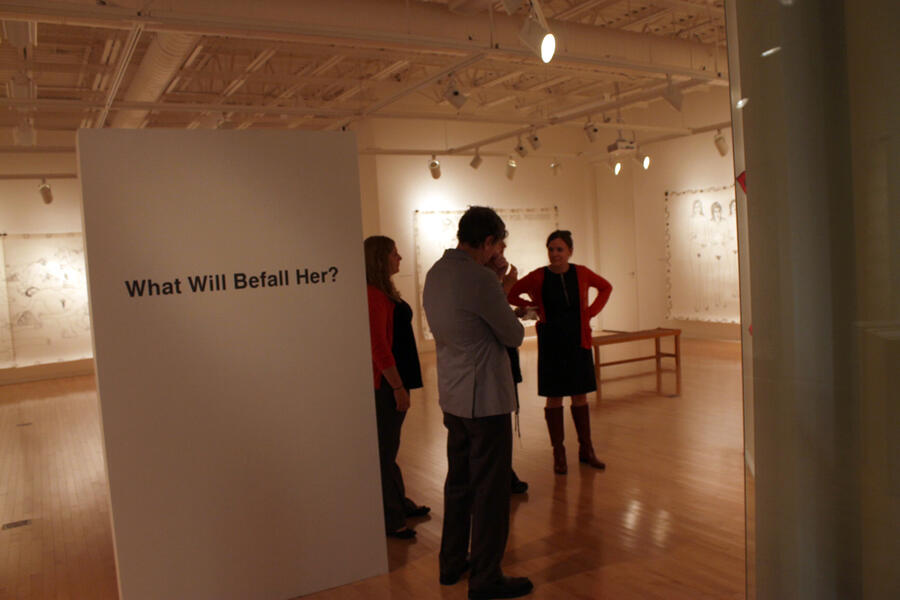 From "What Will Befall Her?" SeriesThis body of charcoal drawings deal with various violence against women and children especially young girls. Sizes varies from 7' X 5' to 7' X 2'0 Feey long on hand-made Korean paper.
From "What Will Befall Her?" SeriesThis body of charcoal drawings deal with various violence against women and children especially young girls. Sizes varies from 7' X 5' to 7' X 2'0 Feey long on hand-made Korean paper. -
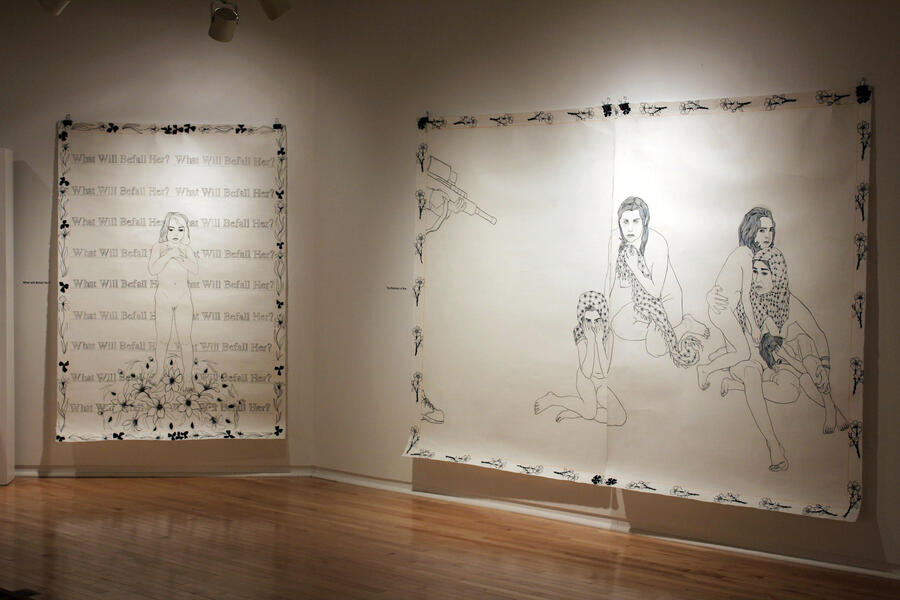 Dishonor of War From "What Will Befall Her?" SeriesIn this shot there are two works on display. "The Dishonor of War" is from the "What Will Befall Her?" series which depicts a solder aiming at innocents women and children during war especially US Iraq war. 7' X 10' .Charcoal on hand-made Korean paper. The second one is called: What Will Befall Her? to the left which is the title work for this series; "What will Befall Her?" 7' X 5', Charcoal on hand-made Korean Paper.
Dishonor of War From "What Will Befall Her?" SeriesIn this shot there are two works on display. "The Dishonor of War" is from the "What Will Befall Her?" series which depicts a solder aiming at innocents women and children during war especially US Iraq war. 7' X 10' .Charcoal on hand-made Korean paper. The second one is called: What Will Befall Her? to the left which is the title work for this series; "What will Befall Her?" 7' X 5', Charcoal on hand-made Korean Paper. -
What Will Befall Her?
-
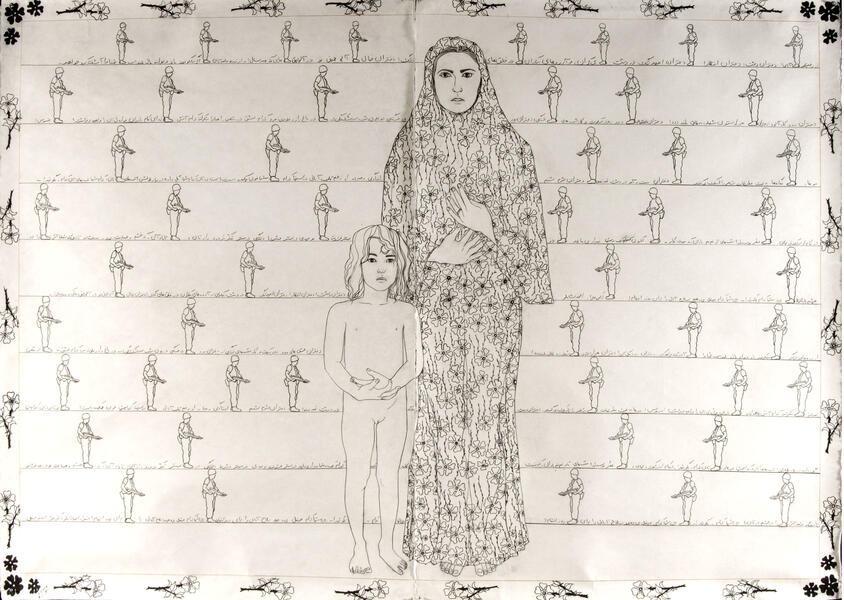 Fahimeh Vahdat,The Soldiers are Coming copy.jpg
Fahimeh Vahdat,The Soldiers are Coming copy.jpgSoldiers Are Coming, from "What Will Befall Her?" Series 7'X10', charcoal on hand-made Korean paper.
Exile and Protest from the "Freedom" series
The interest in the complexity of cultural identity, a sense of belonging to a particular place, a place in society, or a place called “home”… The childhood memories, the language and poetry of the motherland… The pull of the past and the force of the future is like a thread interwoven in the fabric of my work where, as an Iranian-American artist, I choose to advocate for human / women’s & children's rights and freedom of expression. Exile as a form of a forced human condition on displaced individuals has been misunderstood and misused in many ways, especially in contemporary settings. Growing up in Tehran in a Baha’i household with parents of Zoroastrian and Muslim backgrounds in a neighborhood where Armenians, Turks and Jews were living peacefully together, I learned early on that each human being has a story of survival to tell. I also learned that most of ethnic and religious minorities initially chose Iran as their sanctuary, but were persecuted in some form or another as the power structures shifted and changed. Much intolerance and persecution continues in the aftermath of the 1979 Revolution.
-
 Exile: from Freedom seriesMixed media print, drawing on hand-dyed canvas and fabric, sewing, lace. 2014
Exile: from Freedom seriesMixed media print, drawing on hand-dyed canvas and fabric, sewing, lace. 2014 -
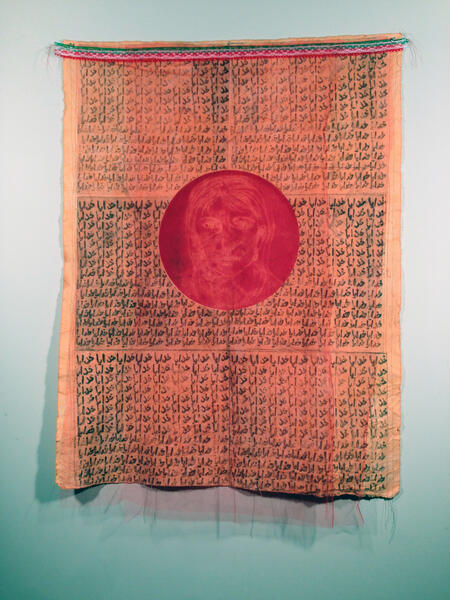 Exile: from Freedom seriesMixed Media Print and hand-dyed canvas and fabric, lace and sewing. 2014, ongoing. This piece was an inspiration for my new and ongoing acid attacks series.
Exile: from Freedom seriesMixed Media Print and hand-dyed canvas and fabric, lace and sewing. 2014, ongoing. This piece was an inspiration for my new and ongoing acid attacks series. -
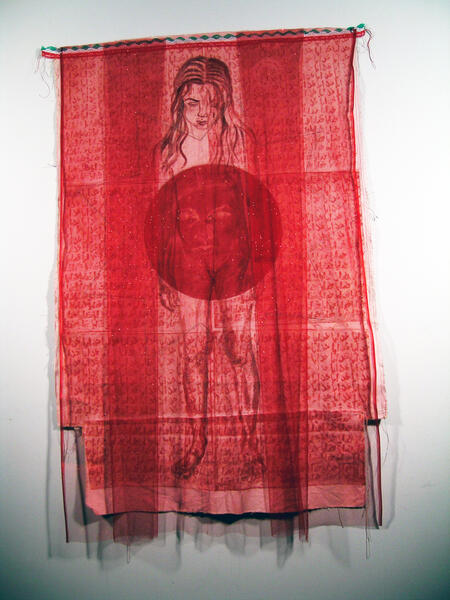 Exile Freedom seiresI was a very young woman leaving Iran and finally to settle down in America. The Exile series examines the most intimate experiences of human beings including my own that becomes universal on its core.
Exile Freedom seiresI was a very young woman leaving Iran and finally to settle down in America. The Exile series examines the most intimate experiences of human beings including my own that becomes universal on its core. -
 from the "Exile" series installation shot, back wall includes "What will Befall Her" drawings
from the "Exile" series installation shot, back wall includes "What will Befall Her" drawings -
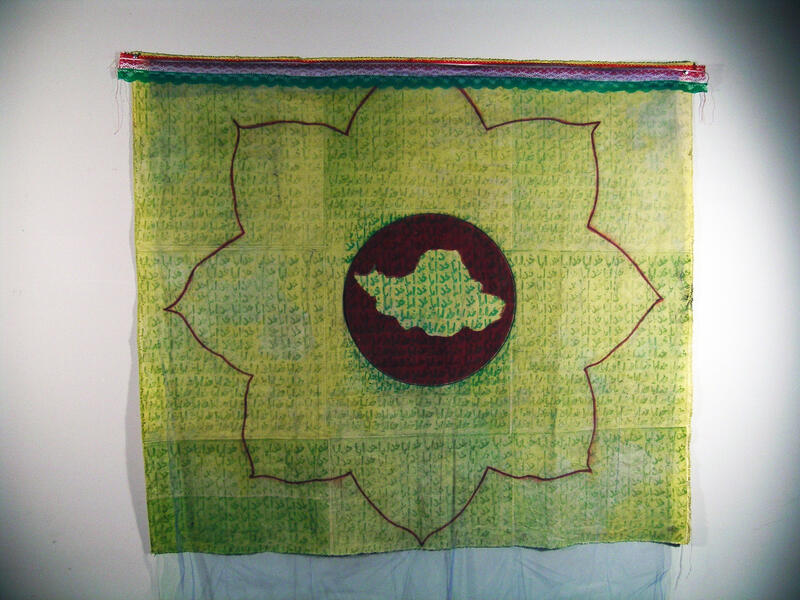 Exile: Freedom seriesThe map of Iran, my former country, is printed on this hand-dyed canvas, but sheer fabrics covers the piece with colors of American flag representing my adopted country.
Exile: Freedom seriesThe map of Iran, my former country, is printed on this hand-dyed canvas, but sheer fabrics covers the piece with colors of American flag representing my adopted country. -
 Where is my Vote? Protest: from "Freedom" seriesImages of protesters from around the world has been printed on this hand-dyed canvas and veiled with fabric and embroidery. 2012- ongoing
Where is my Vote? Protest: from "Freedom" seriesImages of protesters from around the world has been printed on this hand-dyed canvas and veiled with fabric and embroidery. 2012- ongoing -
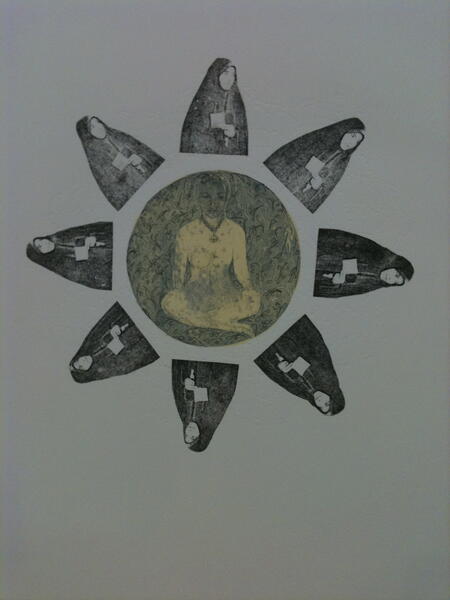 Where is my Women's Rights? Protest: from "Freedom" seriesWhere is my Women Rights? This is a tribute work to Homa who was a doctor educated in USA, but whent back to Iran in 1995, but could not tolorate the contnious abuse of women in public especially the compulsory veil. She put herself on fire in protest. Print and drawing on Paper.
Where is my Women's Rights? Protest: from "Freedom" seriesWhere is my Women Rights? This is a tribute work to Homa who was a doctor educated in USA, but whent back to Iran in 1995, but could not tolorate the contnious abuse of women in public especially the compulsory veil. She put herself on fire in protest. Print and drawing on Paper. -
 Protest: from Freedom seriesMixed media drawing and print on paper, 50"X50", 2012-13
Protest: from Freedom seriesMixed media drawing and print on paper, 50"X50", 2012-13 -
 Protest: from Freedom seriesMixed media painting on canvas, 52"X50"
Protest: from Freedom seriesMixed media painting on canvas, 52"X50"
Evin and Kahrizak Prison Series
In Iran, a country where the right to freedom, liberty and equality are violated daily; in a country where just in one month (February 21-March 21st) human rights defenders documented more than 13,000 incidents of violation of human rights of women, workers, ethnic minorities, religious minorities, students etc.; in a country that has the highest death penalty per capita and the second highest number of executions after China; in a country that is demanding the eradication of laws protecting women and girls because they are considered a threat to national security. In Iran the prisoners of conscious are still fighting for freedom for all and give their lives for it... After the green movement in Iran, many people who disputed the election were arrested, tortured, raped and killed. The Kahrizak prison personnel in Norther Teheran committed the most atrocities against people of Iran. The Eevin Prison is also notorious for its inhumane treatment of its prisoners.
-
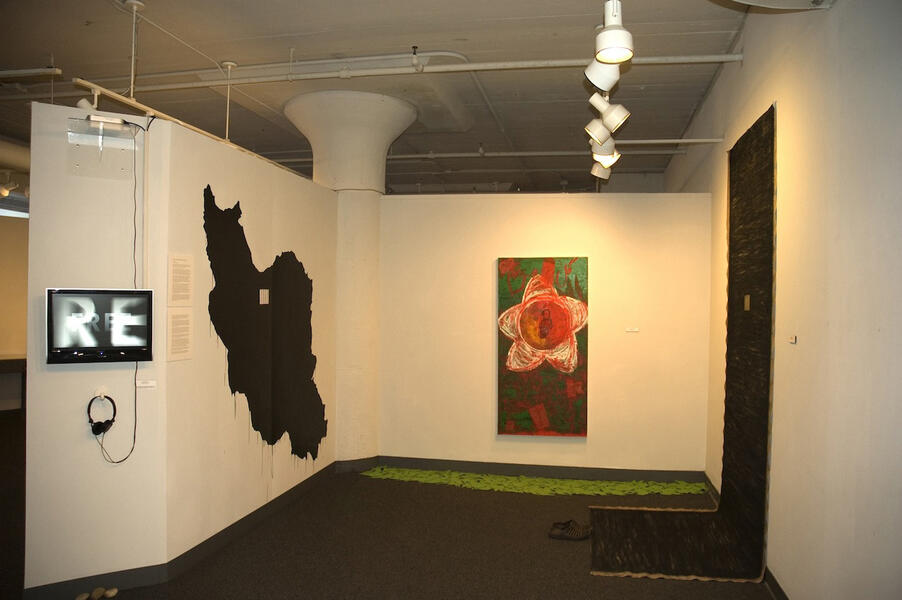 Stop Executions in IranThis is a multidisciplinary installation with video, the map of Iran is directly painted on the wall with an image of prison placed on Tehran the capital of Iran where Kahrizak and Evin prisons are located. It also includes two other installations dealing with the aftermath of the uprising in 2009 and the prison system in Iran. 2010
Stop Executions in IranThis is a multidisciplinary installation with video, the map of Iran is directly painted on the wall with an image of prison placed on Tehran the capital of Iran where Kahrizak and Evin prisons are located. It also includes two other installations dealing with the aftermath of the uprising in 2009 and the prison system in Iran. 2010 -
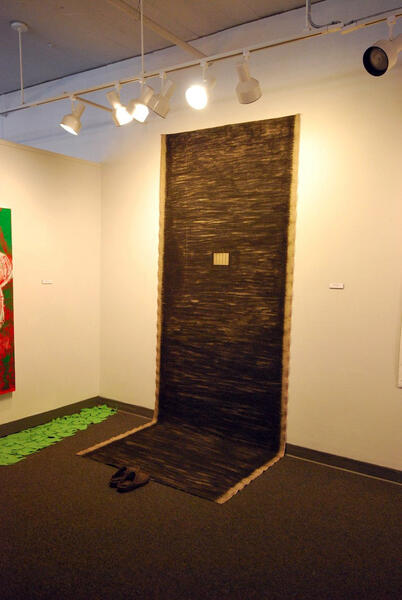 From the" Freedom" Series: Kahrizak prisonThe kahrizak prison has witnessed atrocities no other place in Iran has witnessed during the aftermath of 2009 uprising in Iran. Finally the authorities admitted to those brutal rapes and killings of young men and women that the government had to shot down the prison in 2010.
From the" Freedom" Series: Kahrizak prisonThe kahrizak prison has witnessed atrocities no other place in Iran has witnessed during the aftermath of 2009 uprising in Iran. Finally the authorities admitted to those brutal rapes and killings of young men and women that the government had to shot down the prison in 2010. -
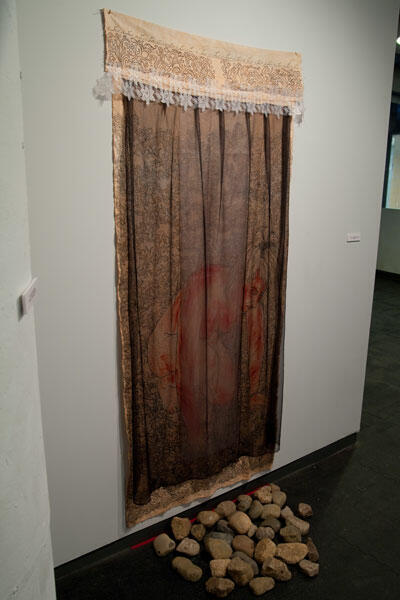 From the "Freedom" Series: StoneStop Stoning in Iran. This piece has actually shown a kneeling woman, bloody, but the three layers of sheer fabrics veils her body. Actual stones are placed in front of the piece on the floor of the gallery as an installation reminding people that the stones has to be the right size for this vicious crime to take place. The entire canvas is filled with flowers and leaves drawn by charcoal. Mixed media print and charcoal on hand-dyed canvas, lace and stone
From the "Freedom" Series: StoneStop Stoning in Iran. This piece has actually shown a kneeling woman, bloody, but the three layers of sheer fabrics veils her body. Actual stones are placed in front of the piece on the floor of the gallery as an installation reminding people that the stones has to be the right size for this vicious crime to take place. The entire canvas is filled with flowers and leaves drawn by charcoal. Mixed media print and charcoal on hand-dyed canvas, lace and stone -
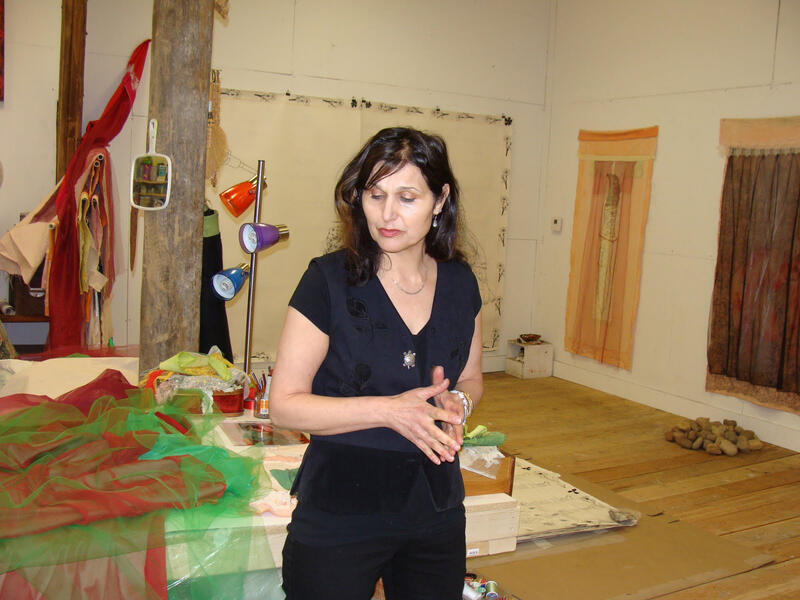 FV in the Studio, from Freedom Series
FV in the Studio, from Freedom Series -
 Detai: From the Freedom Series; Stone
Detai: From the Freedom Series; Stone -
 Protest: Female Ward in Evin prison, From the Freedom SeriesThis piece is a symbolic entrance to the notorious Evin Prison women ward. plastic pink sandals, acrylic and charcoal on linen, 130"X90", 2012
Protest: Female Ward in Evin prison, From the Freedom SeriesThis piece is a symbolic entrance to the notorious Evin Prison women ward. plastic pink sandals, acrylic and charcoal on linen, 130"X90", 2012 -
Installation view from "Freedom" series: RopeIran is the last executioner of children. An etching of the hanged 14 years old girl is covered by a veil over the large portrait of her. Iran is the last executioner of children. An etching of the hanged 14 years old girl is covered by a veil over the large portrait of her. Please zoom in to see the etching on fabric sown on hand-dyed canvas. Please zoom in to see the etching on fabric sown on hand-dyed canvas.
-
Mixed media Installation: Stars, Circles and WomenAn installation view of the exhibition entitled: Stars, Circles and Women dealing with refugee crises in Syria that affected over 15 million people in 2016.







